












Fill one bulk bag per week or 20 per hour with REAR-POST, TWIN-CENTERPOST™ and SWING-DOWN® Bulk Bag Fillers
Flexicon’s extra-broad model range, patented innovations and performance enhancements let you exact-match a filler to your specific cost and capacity requirements. Patented TWINCENTERPOST™ models maximize strength, accessibility to bag loops and economy. Cantilevered REAR-POST models allow passthrough roller conveyors. SWING-DOWN® models pivot the fill-head to the operator at floor level for quick, easy and safe spout connections. Optional mechanical and pneumatic conveyors.
Loosen material solidified in bulk bags during storage and shipment with BLOCK-BUSTER® Bulk Bag Conditioners
Opposing hydraulic rams drive contoured conditioning plates to crush and loosen solidified bulk material safely and easily. Bulk bags can be raised, lowered and rotated to allow complete conditioning of the entire bag through the use of automated turntables and scissor lifts, or electric hoist and trolley assemblies. Offered as stand-alone units for loading with forklift or electric hoist and trolley, or integrated with bulk bag dischargers for reduced cost, footprint and loading time.
Save time, money and space with BULK-OUT® Multi-Function Bulk Bag Dischargers and Weigh Batching Stations



Condition, de-lump, screen, feed, weigh batch, combine with liquids, and convey as you discharge, with a custom-integrated, performance-guaranteed, dust-free discharger system. Offered as stand-alone units for loading with forklift or electric hoist and trolley, split frames for low headroom areas, economical half frames and mobile frames. All available with mechanical and pneumatic conveyors, flow promotion devices, bag dump access, automated weigh batching packages, and much more.

The GEA SmartPacker TwinTube is renowned for its productivity and efficiency. Now, with its ability to handle 160mm pillow bags it’s more flexible than ever. Format changes for the entire format range are simple, quick and require no tools. And, with its capability to run either mono material or paper-based bags, it is more sustainable as well.

SmartPacker CX400 D-Zip takes sustainability even further
The GEA SmartPacker CX400 D-Zip gives you the best of both worlds: the high quality bags of conventional horizontal machines plus the advantages of a SmartPacker.
Get smart. See our SmartPacker innovations at Pack Expo 2023.

Whether getting help from an energy company, environmental organization, or government entity or engaging employees to develop resource-saving ideas, working together gets the job done.

18 OpX Intel: Managing Employees for Daily Improvement

Regardless of your specific approach, MDI aims to improve communication and data flow, especially on the shop floor, identifying problems quicker and growing skillsets.
42 SunOpta Takes Aseptic Processing to New Level

As a greenfield plant, SunOpta has been able to take the best of everything from its three other plants and improve them further— from e ciencies and sustainability to sanitary design and safety..



54 Tech Today: ERP Meets Producers Where They Are
Increased interconnectivity and cloud-based systems bring sophisticated ERP software capabilities to small and medium-sized companies as well as the big players.
66 Case Study: Johnsonville
Immersion Cook/Chill System Provides Orderly Outcome
CONTENT
EDITOR-IN-CHIEF AARON HAND 312/488-3392 ahand@pmmimediagroup.com
SENIOR EDITOR MICHAEL COSTA mcosta@pmmimediagroup.com
NEW PRODUCTS EDITOR MORGAN SMITH msmith@pmmimediagroup.com
CONTRIBUTING EDITORS
CONNECT WITH US
@ProFoodWorld
@ProFoodWorld www.linkedin.com/ showcase/profoodworld
@ProFoodWorld
JEANNE SCHWEDER, STEPHEN PERRY, STEPHEN SCHLEGEL, JEFFREY BARACH
CREATIVE DIRECTOR DAVID BACHO ART DIRECTOR KATHY TRAVIS
ADVERTISING
VICE PRESIDENT, SALES JOHN SCHREI jschrei@pmmimediagroup.com
PUBLISHER PATRICK YOUNG pyoung@pmmimediagroup.com • 610/251-2579
ACCOUNT EXECUTIVE BRIAN J. GRONOWSKI bgronowski@pmmimediagroup.com • 440/564-5920
PRODUCTION MANAGER LARA KRIEGER lkrieger@pmmimediagroup.com
FINANCIAL SERVICES MANAGER JANET FABIANO jfabiano@pmmimediagroup.com
PMMI MEDIA GROUP
PRESIDENT DAVID NEWCORN
VICE PRESIDENT, DIGITAL ELIZABETH KACHORIS
DIRECTOR, DIGITAL MEDIA JEN KREPELKA
SENIOR DIRECTOR, CONTENT & BRAND GROWTH MIKE PROKOPEAK
SENIOR DIRECTOR, EVENTS TREY SMITH
DIRECTOR, MARKETING SHARON TAYLOR
FOUNDING PARTNER AND EXECUTIVE VICE PRESIDENT, INDUSTRY OUTREACH, PMMI JOSEPH ANGEL
FOUNDING PARTNER LLOYD FERGUSON
ProFood World • PMMI Media Group 401 N. Michigan Ave., Suite 1700, Chicago, IL 60611
Phone: 312/222-1010
• Fax: 312/222-1310
Email: info@pmmimediagroup.com • Web: www.profoodworld.com
PMMI, The Association for Packaging and Processing Technologies 12930 Worldgate Drive, Suite 200, Herndon, VA 20170 Phone: 571/612-3200 • Fax: 703/243-8556 • Web: www.pmmi.org



Staff at PMMI Media Group can be contacted at info@pmmimediagroup.com.

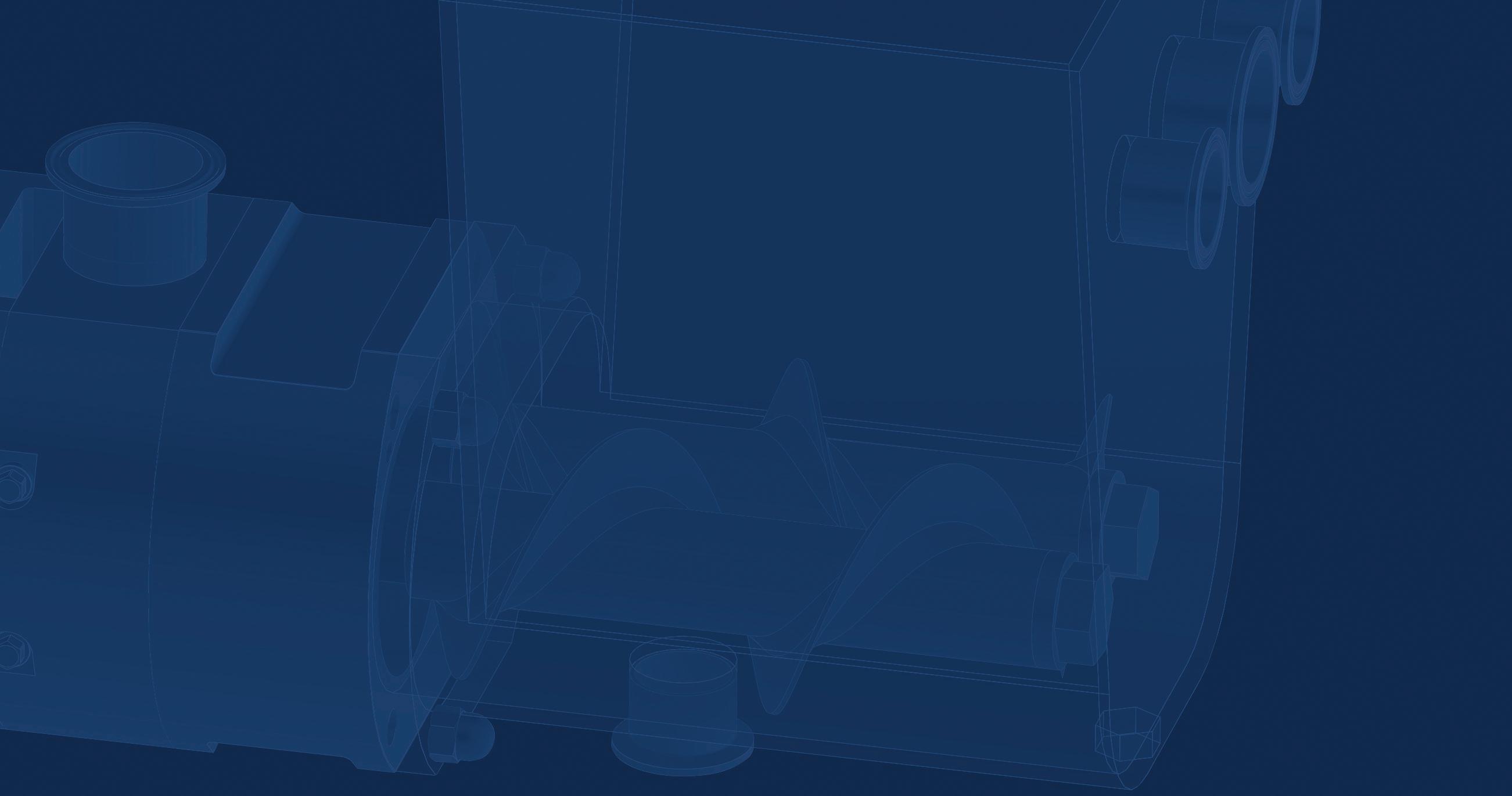













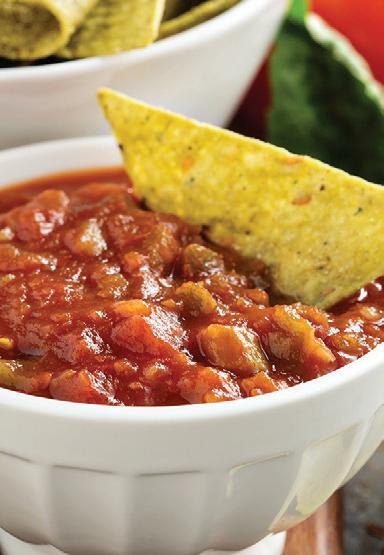





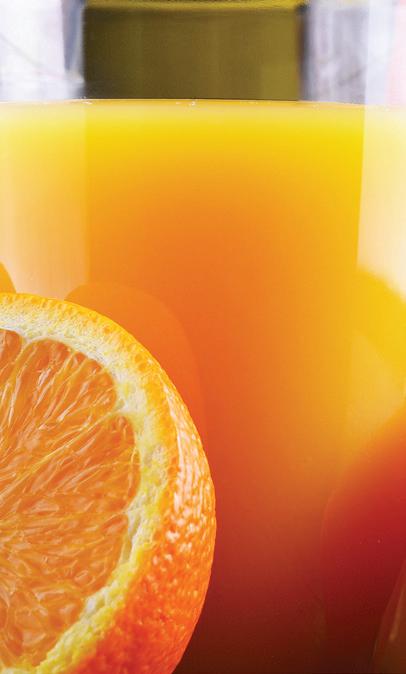




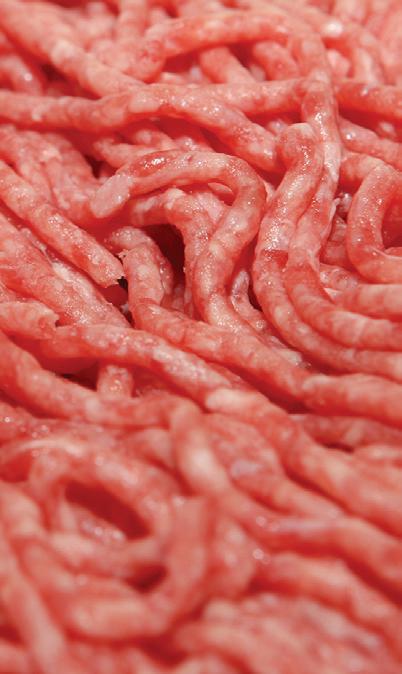





The world faces increasing levels of food security, and there’s much that this industry can do to combat that—and save more of its own resources.
Each year, billions of pounds of good food are wasted. Whether it’s crops that never get harvested or food left to expire at home or in restaurants, there are any number of reasons why food doesn’t make it into the mouths of people facing food insecurity. Everybody up and down the supply chain has a role to play in reducing food waste.
We recently saw a success out of Bob’s Red Mill, which won a Sustainability Excellence in Manufacturing Award (SEMA) this year from ProFood World for zeroing in specifically on a food waste problem in its production process. The company made a relatively simple adjustment to the conveyor on one of its grain lines—reducing grain spillover and thereby reducing its wasted food per pound on that line by more than 70%.
From a food manufacturer’s perspective, it’s not always in the production process where food waste occurs. It could be looked at from several angles—creating formulations or using technologies (high-pressure processing or aseptic processing, say) that enable longer shelf life for perishable goods, optimizing shipping routes from supplier to processor to retail, rethinking the packaging that might keep that food fresher for longer, and improving labeling practices, to name a few.
Of course, reducing food waste is just one part of the larger discussion of sustainability. Having recently completed the judging of our SEMAs, sustainability is fairly top of mind around here. But then, sustainability has become top of mind for a lot of food and beverage producers these days.
They’re being held more and more accountable by consumers to be transparent, ambitious, and successful when it comes to their environmental agendas. But they also know that many of those sustainability projects—reducing energy, water, materials, food waste, and more—are going to pay for themselves in relatively short amount of time.
Read “Collaboration Pushes Sustainability Forward” on page 30 to learn more about our latest SEMA-winning programs and projects from Conagra Brands, Hormel Foods, Bob’s Red Mill, and Smithfield Packaged Meats.
EDITORIAL ADVISORY BOARD
CHRISTINE BENSE
CHIEF SUPPLY CHAIN OFFICER
Turkey Hill
GREG FLICKINGER
CHIEF OPERATING OFFICER
Nobell Foods
JOHN HILKER

SENIOR VP, OPERATIONS
Kite Hill
VINCE NASTI
VP, OPERATIONS
Nation Pizza & Foods
JIM PRUNESTI
VP, ENGINEERING
Conagra Brands
LISA RATHBURN
VP, ENGINEERING
T. Marzetti
MARK SHAYE

VP, ENGINEERING
Ken’s Foods
TONY VANDENOEVER
CONSULTANT, FOOD MANUFACTURING ENGINEERING
Waterfall Ventures
DIANE WOLF
FORMER VP, ENGINEERING AND OPERATIONS
Kraft Foods
BROOKE WYNN
SENIOR DIRECTOR, SUSTAINABILITY
Smithfield Foods

Agitators forced through stationary materials impart shear needed to reduce agglomerates and blend pastes and slurries. Basic industrial units to state-of-the-art sanitary designs with heating/cooling jackets, liquid spray additions, and high-speed choppers/intensifiers. Capacities from 1 to 1,150 cu ft (.03 to 32 m3).
Smooth internal surfaces free of baffles, shafts and bearings allow unobstructed material flow, plus complete discharge through a gate valve for rapid cleaning or sanitizing of the easy-access interior. Uniform blends are typically achieved in as little as 15 minutes with equal efficiency at fill volumes from 100% to 25% of capacity. Ideal for dry and granular materials.

n 100% Uniform blending and/or liquid additions in one to 2–1/2 minutes
n Total discharge with no segregation
n Ultra-gentle tumbling action (versus blades forced through batch)
n Ultra-low energy usage
n Equal efficiency from 100% to 15% of capacity
n No internal shaft or seals contacting material unlike other rotary mixers
MUNSON® Fluidized Bed Mixers feature two shafts with paddles that counter-rotate at high speeds to fluidize material, achieving homogeneous blends in 10 seconds to 2 minutes. Low shear forces minimize friction with little or no degradation and insignificant heat generation. Drop-bottom gates provide rapid discharge. Capacities from 0.21 to 283 cu ft (6 L to 8 m3).
Remove lumps and agglomerates from bulk foods. Dual rotors with three-point, singlepiece breaking heads rotate with minimum clearance inside a curved, perforated bedscreen. On-size material exits through bedscreen apertures from 1/32 to 2–1/2 in. (0.8 to 63.5 mm) in diameter. Fits tight spaces between upstream and downstream process equipment.


+1-315-797-0090 | USA: 1-800-944-6644
INFO@MUNSONMACHINERY.COM MUNSONMACHINERY.COM

Coarse to fine grinding of friable powders, flakes and granules into controlled particle sizes at high rates per HP/kW. High-speed rotation of the inner disc creates centrifugal force that accelerates bulk material entering the central inlet of the opposing stationary disc through five intermeshing rows of pins. Desired tight particle size distribution obtained by controlling the rotor speed.
ROTARY BATCH MIXER Fast yet gentle 4-way mixing action: fold/tumble/cut/turnPRODUCT:
AVAILABLE
PORTION:
PRODUCT:








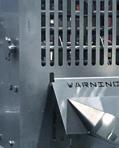


Cheeses, IQF Vegetables, IQF Meats, Nuts, Streusel & More



AVAILABLE WIDTHS:

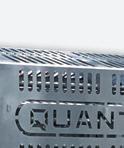












18” Usable Product Belt 24” Usable Product Belt











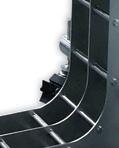
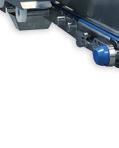








PORTION: Fully Adjustable




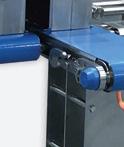
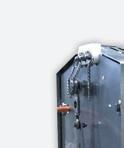




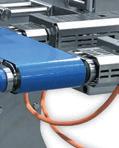
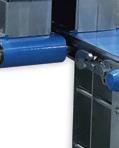
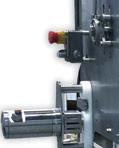

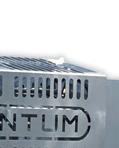












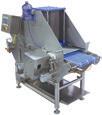


FEATURES:

THE FOOD AND AGRICULTURE INDUSTRY
hasn’t traditionally been mentioned as a cybersecurity target like the banking and healthcare industries, which have been (and continue to be) hit hard by ransomware and other threats, resulting in millions of dollars lost, and in some cases the closure of facilities due to the fi nancial impact of those incidents.

The 100-acre fairlife production facility in Webster, N.Y., will source milk from local cooperatives to produce dairy-based beverages.


McCormick’s board of directors has announced the promotion of Brendan Foley to president and CEO, e ective Sept. 1, as well as his election to the board, e ective immediately.


The recently launched Food and Ag-ISAC aims to collectively mitigate cyberattacks on the industry, with help from companies like Bunge, Cargill, Conagra, Corteva, PepsiCo, and Tyson.


But recent attacks to brands like JBS, Schreiber Foods, Sysco, Dole, and others, have prompted an updated version of the food and agriculture information sharing and analysis center (Food and Ag-ISAC), which originally existed from 2002 to 2008 but was discontinued due in part to a lack of interest by companies to participate and share information with each other.
More than a decade later, it’s clear the food and agriculture industry is in the crosshairs of cybercriminals, so the 2023 version of the Food and Ag-ISAC—which launched in May—operates as its own entity and not a subgroup, and has the initial backing of food giants Bunge, Cargill, Conagra, Corteva, PepsiCo, and Tyson.
“The industry thrives when there is a healthy value chain,” says Paul Hershberger, cyber command center leader at Cargill. “The threats we face are most often common across the industry and the ability to manage

Monster Beverage and Vital Pharmaceuticals have entered into an asset purchase agreement under which a subsidiary of Monster would acquire Bang Energy’s assets.
PepsiCo is working with the Stanford Institute for HumanCentered Artificial Intelligence Corporate A liates Program, contributing to its consumer goods, retail, and AI focus areas.
A Cargill plant in Chambersburg, Pa., is turning tens of thousands of pounds of Hershey’s chocolate waste per year into nutritious feed ingredients for cows, pigs, and other livestock.
those threats is realized through openly sharing threat intelligence. The more we as an industry can share information about threats and potential attacker tactics, techniques, and procedures, the more effective we can be in preparing to mitigate those threats and supporting a resilient food and agriculture value chain.”
The threat landscape is more complex than ever, according to Steve Stellmacher, global director, cyber threat defense operations at Bunge. “There is a direct correlation between the increase in the use of technology and the level of exposure that the technology alters to an organization’s threat surface,” he says. “We can all observe the increase in cyber-based attacks. What was a weekly news item just a year ago is now more frequent and disrupts the business processes, the supply chain, or customers directly. While [members] may be competitors within the industry, we also have a common vested interest to be active stewards and work to preserve, share information, and protect our market space as a whole.”
Those at the Food and Ag-ISAC say the organization provides curated threat intelligence so companies can identify attacks, incidents, and threat indicators, enabling them to share and deploy effective mitigations to protect their companies and the entire food and agriculture sector. The Food and Ag-ISAC is the only information-sharing group dedicated to serving the food and agriculture industry, where connectivity and technology are increasingly integrated into that sector.
We sat down with Scott Algeier, executive director of IT-ISAC, to find out why the Food and Ag-ISAC was resurrected and given a prominent place under the IT-ISAC umbrella in 2023, and what has changed in food and agriculture cybersecurity since 2008.

designated ISAC for the food and agriculture industry. Over the last 18 months, there’s been increased recognition by the food and agriculture sector that they were one of the few without a designated ISAC. Within member companies and the community, we have seen renewed interest, so we figured this was a good time to launch a Food and Ag-ISAC and grow it with a focus on sustained success this time.
Today’s Food and Ag-ISAC is starting with sensibilities already in place from our previous version. We have a strong core of member companies who are significant industry players and are adopting it, and they’ve already been engaging with each other for over a decade. Some of those growing pains the first ISAC had, like trying to build trust with members and trying to build capabilities to help them, I think we’ve overcome those. Today, we already have capabilities, we already have trust, and we already have analysis. We’re not starting from scratch, we’re building off of a solid foundation.
PFW: Let’s say one of today’s member companies experiences a cyberattack. How does the Food and Ag-ISAC become involved?
ALGEIER: The model that we have is food companies will be the primary responders to the incidents. They’re the ones who are responsible for identifying the incident and managing containment during the incident response, but [with Food and Ag-ISAC] they have a community of analysts within the industry that help them. They have various methods through setting up meetings, secure checks, email listservs, regularly scheduled meetings, contacting the operations team, and contacting companies individually that they’ve been working with through the ISAC. They can communicate with each other: “We’re seeing this. We’re not sure what it is. Is this familiar to you? Have you seen this before?”
ALGEIER: Having a special interest subgroup within the IT-ISAC isn’t the same as having a
We also have adversary attack playbooks on multiple threat actors they can consult, and we have ransomware trackers they can view. If a company is victimized from a ransomware campaign, we have a tracker that can help them identify indicators within our intelligence management platform that correlates to other incidents. We also think that by sharing this information ahead of incidents that it increases the chance companies will be able to manage these risks. And if they do become a victim, they’ll be able to recover more quickly because of the total capabilities we offer them.


PFW: Generally speaking, why would a food company be targeted for a cyberattack?

ALGEIER: I think different actors have different motives. Why would they attack an oil and gas company or a healthcare company? Some cybercriminals are looking for money, and some nation/state actors are looking for intellectual property. Of course, there’s always the possibility that critical infrastructure can be targeted by a nation/state for disruption.
I think the food and agriculture industry is like most other critical infrastructure sectors, which is you have larger enterprises with more resources that are generally better able to defend themselves than the smaller enterprises with fewer resources. And one of the goals that we have within our Food and Ag-ISAC is to help increase the security level of those smaller enterprises, so we can drive secure practices back to them and they can elevate their defenses and improve their mitigation and incident response.
PFW: Does each Food and Ag-ISAC company monitor its cybersecurity using its own in-house equipment, or is there some level of standardization of tools to make it easier for members to communicate with each other?

ALGEIER: Not everyone is using the same equipment and not everyone uses equipment in the same way. They have their own risk management plans, they deploy tools, technologies, and response plans. They make their own security investments based on what they think is right for their company.


We do provide a toolset they can plug into and we have our intelligence management platform they can plug their security tools into so they can get the indicators that we’re seeing and uploading that other member companies are seeing. And then through this platform, companies will be able to pull those indicators from the platform into their security tools. So, there is a common technology that we all leverage through the IT-ISAC for indicator sharing. But once you get into the enterprises, the companies make their own investments on security and technology tools they deploy internally.

PFW: Are there plans to have a Food and Ag-ISAC annual meeting for member companies to check in with each other in person?
ALGEIER: We’re working towards annual meetings, but we currently have virtual meetings every other week where the analysts from the member companies come together to talk about what new threats they’re seeing, what they’re monitoring, what potential vulnerabilities have announced, how that’s impacting them, and how they’re mitigating them. We also have other ways our members communicate between meetings like secure chat listservs.
PFW: Was there anything you wanted to add or something we missed?
ALGEIER: We’re really excited about the great feedback we’ve received and the support we have from the industry, our policymakers, transportation partners, and the food and agriculture industry, who really are supportive of the Food and Ag-ISAC mission and our common desire to defend this critical infrastructure. We look forward to working together to protect each other and the industry as a whole. I think it’s an exciting time for the industry, and it’s great they now have an industry-led forum to help manage risk.
ROSS Ribbon Blenders meet the toughest requirements for quality materials and heavy-duty construction. Standard features include thick stainless steel troughs, low-maintenance gearmotors, BISSC-certified design and much more.





Need a Ribbon Blender customized for your process? ROSS offers MANY options. Complete control systems, spray nozzles for coating, pressure feed vessels and vacuum operation, to name a few.





Used in a wide range of food applications, from granola and drink blends to soups, spices and plant-based proteins, we can customize a ROSS Ribbon Blender for your application.

Sizes from ½ cu. ft. to 1000 cu. ft. A variety of standard models are in stock for faster delivery. Available worldwide.

CALIFORNIA-BASED cultivated meat brands Upside Foods and Good Meat (the cultivated meat subsidiary of Eat Just) have been granted the final step of USDA approval to sell their chicken products commercially in restaurants and retail, and are the first two in the U.S. with that regulatory clearance. The companies had already received FDA approval, as both USDA and FDA approval are needed in the U.S. to sell cultivated meat. Good Meat previously received approval to sell its chicken in Singapore in 2020, the only other country until now to do so.
While the expense of producing cultivated meat currently keeps it from reaching price parity with meat harvested from live animals—particularly the cost and availability of media to feed animal cells while they grow in tanks—two high-profile restaurateurs have partnered with the companies to sell cultivated chicken on their menus. Chef Dominique Crenn will serve Upside’s chicken at her Bar Crenn in San Francisco, and Chef José Andrés will serve Good Meat’s chicken at one of his restaurants (not
yet disclosed) in Washington, D.C.
Generally speaking, cultivated meat is grown from primary animal cells in cultivators similar to fermentation tanks for breweries, with some companies using edible scaffolding made of substances like soy or algae, for cells to latch onto and grow into an undefined piece of meat. Because cultivated meat doesn’t grow into specific animal parts, like chicken legs or thighs for example, the finished mass of meat is formed later into whatever the company wants to sell, like nuggets, tenders, or even whole-muscle slabs.
During an interview I had last year with Lou Cooperhouse, president and CEO of San Diegobased cultivated seafood company BlueNalu, he predicted the 2030s would be the decade where cultivated meat would reach price parity as the industry figures out its supply chain for feed media and other expenses that keep it from immediately reaching wide-scale grocery distribution today.

Josh Tetrick, co-founder and CEO of Good Meat and Eat Just, says the USDA approval to “produce and sell cultivated meat in the United States is a major moment for our company, the industry and the food system. We have been the only company selling cultivated meat anywhere in the world since we launched in Singapore in 2020, and now it’s approved to sell to consumers in the world’s largest economy. We appreciate the rigor and thoughtfulness that both the FDA and USDA have applied during this historic two-agency regulatory process.”
Eric Schulze, vice president of global and scientific affairs at Upside Foods, says, “We at Upside Foods have long championed the dual regulatory jurisdiction of FDA and USDA, starting with a historic partnership with the North American Meat Institute in 2018. Since then, our team has been working diligently with both agencies to bring our cultivated chicken to market.”
No word from either company yet about specific plans to scale up production and expand their processing
capabilities now that they can sell products to the public, but Upside’s plant in Emeryville, Calif., was future-planned with FDA and USDA approval in mind, and is capable of producing up to 400,000 lb of cultivated meat per year.

The USDA ruling “not only legitimizes this new kind of food production but also creates a visible regulatory pathway for other companies in the field. It encourages scaling up production, attracting more investment, and thus expansion of facilities,” says Justin Dranschak, director of biopharma at Molecular Devices, a company that works behind the scenes with cultivated meat companies with analysis and other services related to the development and growth of cell-cultured meat. “With other companies like BlueNalu and Wildtype developing some unique products, this will help push the industry into approvals for other models like fish.”
In other cultivated meat news, global protein giant JBS announced in July it was building one of the world’s largest cultivated meat plants in San Sebastian, Spain, which will be JBS’s first commercial-scale facility of this kind. The $41 million plant— built on a 215,000-sq-ft plot of land—is expected to produce more than 1,000 metric tons of culti-
Prior to USDA approval, Good Meat was selling its cultivated chicken in Singapore, which gave Good Meat regulatory clearance in 2020, and was the only country until now to allow it.
vated meat per year, with the potential of expanding to 4,000 metric tons in the future. The facility is expected to open by mid-year 2024 and will be owned by cultivated meat firm BioTech Foods, with JBS as the majority shareholder.
 PHOTO COURTESY OF GOOD MEAT
PHOTO COURTESY OF GOOD MEAT
BUSINESS IS BOOMING on the beverage front, with companies reporting expansion in every metric of the beverage industry purchasing index in 2023.
That’s according to PMMI Business Intelligence’s 2023 report, “Purchasing Plans and Priorities.”
The industry’s growth comes at a slightly slower pace than the overall market, but it is a significant improvement compared to the contractions from the most recent Q2 2022 measurement.
The 2023 purchasing index measures industry performance based on three main metrics, all aligned with CPG responses to a survey conducted for the report. It measures equipment investments, scheduled projects, and the number of SKUs manufactured. An index of 50 represents no change.
This year’s equipment investment activity shows expansion at 71.9 points, as does the metric for scheduled projects at 68.8 points and new SKUs at 75 points.
Interviewed companies expect moderate growth in 2023, and most indicate plans to move forward with investments. Although inflation impacts some beverage sector niches, most companies expect demand to continue growing, although at a slower pace than in years prior.
“Soft growth” is the mean expectation.
Beverage industry buys domestic
Only 44% of companies interviewed have purchased equipment originating outside of North America in the past two years. Of these purchases, the majority have been secondary packaging equipment.
Overall, beverage companies perceive North American manufacturers as providing good quality, reliability, performance, and value. In addition, they consider North American machinery to be more flexible, simple, and easy to service or maintain.
By contrast, they have found European machinery to be more complex, with interphases, systems, and manuals that are often too technical for operators.
Service is the area where beverage companies believe packaging machinery suppliers could improve.

Beverage companies have seen progress in spare parts delivery times. As one surveyed industry stakeholder says, “We stack common wear spare parts, and we have seen a significant improvement in delivery times. Now we are getting parts within 24 hours, while one year ago, we had to wait several days.”
Though some aspects of service have improved, these companies have not had a timely response from machinery suppliers when there is a problem on their lines.
“Packaging machinery companies can improve by getting somebody on the phone that is knowledgeable of the equipment and who can respond quickly,” the same industry stakeholder says.
They add that machinery suppliers should also train their service personnel on digital capabilities, explaining, “They send technicians who are knowledgeable about mechanical issues, but when problems originate from connectivity or software, they don’t know what to do.”
The industry stakeholder adds that service technicians should have access to better troubleshooting databases for better problem-solving capability. “Technicians have given us three different opinions on how to address the same problem, and they still haven’t been able to resolve it,” they say.














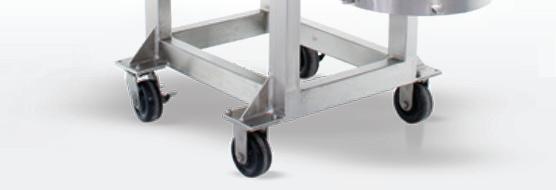

























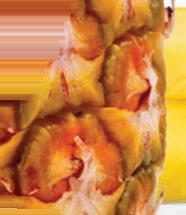



















CONTRIBUTORS:
Doug Herald, Co-CEO, Covenance Group Manufacturing Dan Sileo, Head Coach Manufacturing, FSO InstituteRegardless of your specific approach, MDI aims to improve communication and data flow, especially on the shop floor, identifying problems quicker and growing skillsets.

MANAGING FOR DAILY IMPROVEMENT (MDI) has a rich history. Many in manufacturing know it as daily direction setting (DDS) from P&G’s Integrated Work Systems or as the Floor Management Developmental System (FMDS) from the Toyota Production System. Regardless of its origin, the introduction of an MDI model for transformative success into the food and beverage industry can greatly accelerate manufacturing performance and sustain the results. It inverts the traditional management hierarchy within a plant with new methods and work processes that enable employees to engage deeper and be more successful.
Regardless of which MDI system you choose, they all have a common purpose:
• Enabling communication and data flow at all levels of the production facility with special emphasis on the shop floor.
• Identifying problems quicker and putting solutions into play to solve them.
• Growing peoples’ skillsets and career opportunities.
Because of these, an MDI process provides a backbone or engine that greatly increases total employee engagement in its three most important pillars—empowerment, enablement, and communication. To learn more, see OpX Leadership Network document on Workforce Engagement (pfwgo.to/engage).
To learn more about MDI and how it’s used in real life, FSO Institute spoke with two of its most vocal champions: Doug Herald, co-CEO at Covenance Group Manufacturing, and Dan Sileo, FSO coach, formerly at Sunny Delight.
FSO INSTITUTE: Doug, you’ve used MDI frequently throughout your career for productivity improvements and for improvement in the careers of your work associates. How does MDI work?
DOUG HERALD: One of the greatest difficulties in implementing MDI is overcoming the traditional top-down mindset of management. At the heart of MDI is two-way communication, not one-way command-and-control. MDI is dependent on the deep engagement of employees that strives to capture the ideas, skills, and talent of those on the shop floor who live their manufacturing existence every day. By engaging them and collaborating with




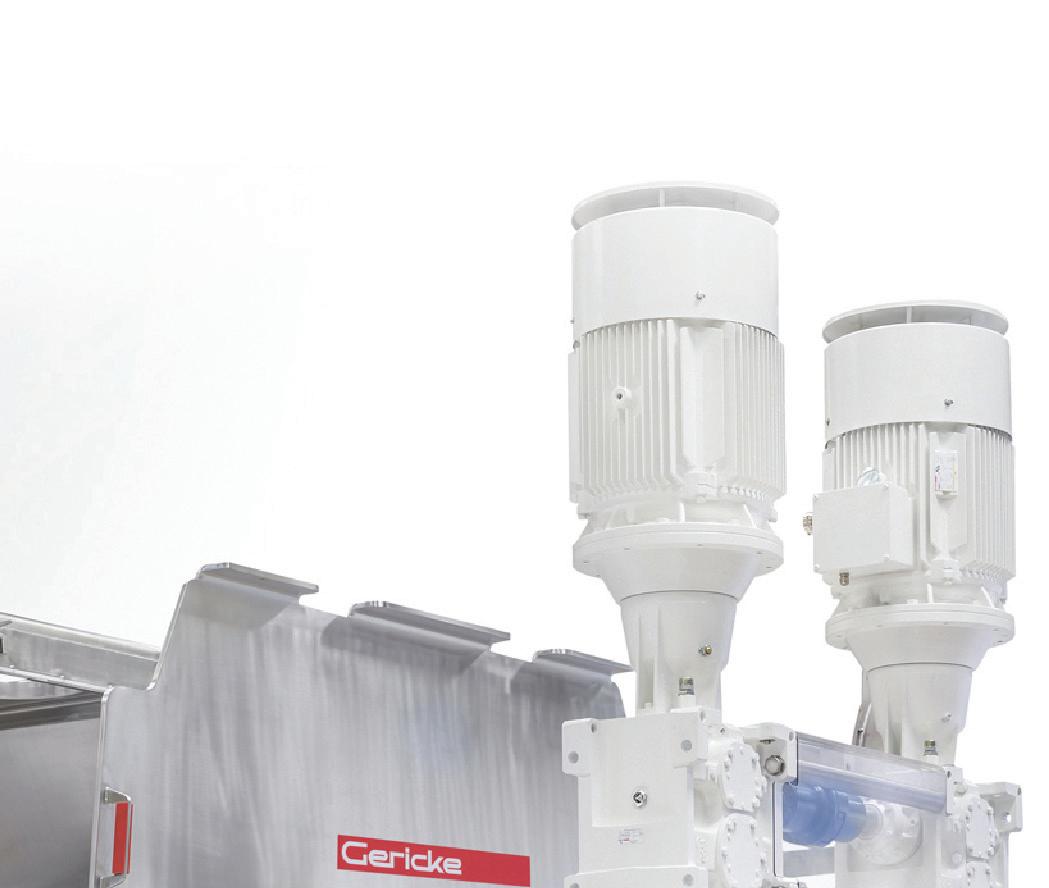
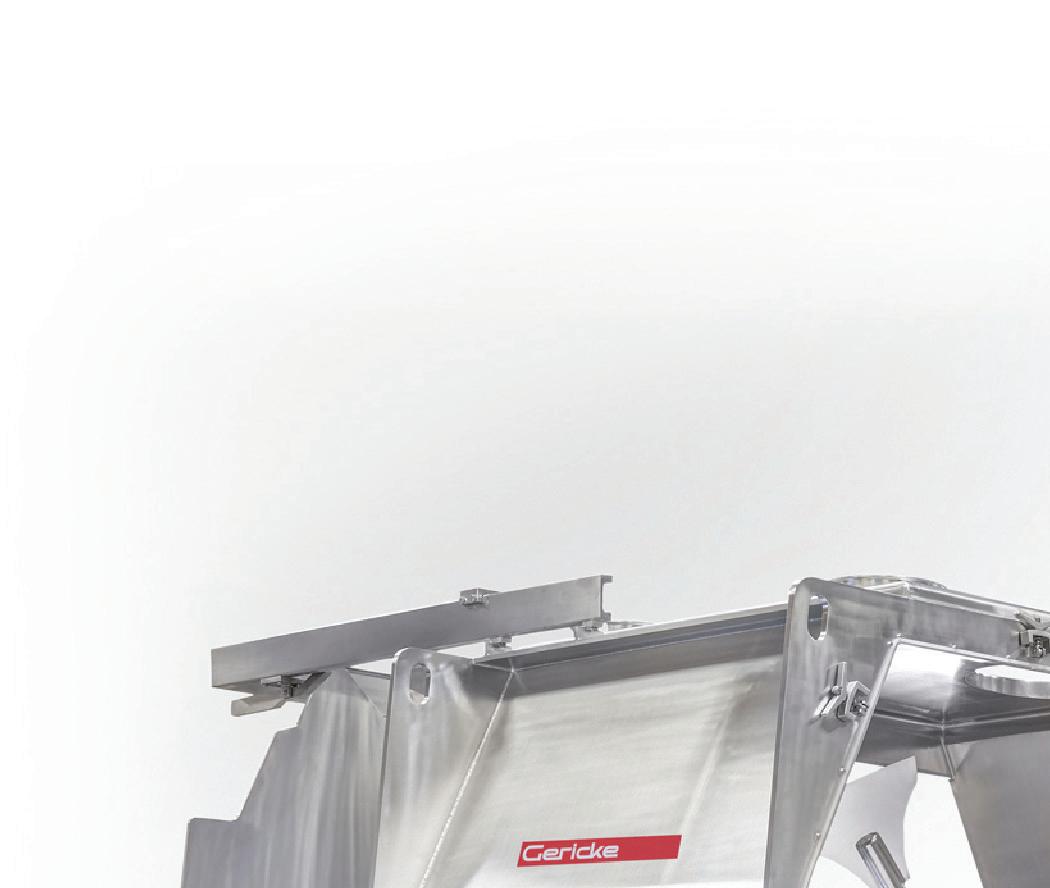

them, productivity improvement opportunities are identified and attained with greater ease. There are five fundamental pillars in an MDI process: safety, quality, people, service, and cost. As to how MDI actually works, there are a few critical things to consider:

• Commitment throughout the organization: While leadership may not be involved in the day-to-day, they must understand the concept, support it, and realize the financial benefits to be gained. And certainly, closer to the shop floor, there must be individual commitment as well.
• Educating yourself: All must understand the value of servant leadership, the idea that it is leadership’s job to make everyone around them successful. This is a significant change in mindset that is illustrated in the Toyota inverted pyramid and FMDS roadmap.
• Training: Initially and quickly, you train shop floor employees on the MDI concept. You then move to a “learn by doing” method. This is led by shop floor leadership generally on one line that serves to set up a model for MDI implementation. It is critical during train-
ing that employees buy in, take ownership, and become advocates for the MDI process. Once the model becomes standard operating procedure, it can be positioned for rapid reapplication across plants and the broader enterprise.




• Link training to KPIs: Be sure that training is linked to the most important key performance indicators. In fact, during training, it is not unusual for KPIs to be adjusted as employees are learning by doing.
• Monitor results: Through Gemba Walks and other methods, employ a PDCA (Plan, Do, Check, Adjust) process so that agreed-upon outcomes are realized. Throughout the entire process don’t forget to celebrate successes with the entire team!

One of the most important things to remember about MDI is that it is task-driven. But done properly, the tasks become a tool.
FSO INSTITUTE: Dan, Doug mentioned the financial benefits of implementing MDI. Can you provide an example of how MDI benefits a manufacturer financially?





Manufacturing food and beverages require robust, reliable, and durable equipment solutions. In addition, ingredients must be handled gently, added precisely, and mixed efficiently. We have extensive knowledge of food and beverage production, and our application experts can develop and deliver a solution to handle your most demanding applications. www.scottmixers.com































DAN SILEO: One of the best examples involves how manufacturers deal with product waste. In one example, a War on Waste was declared, resulting in a $2.5 million dollar savings for the manufacturer. They did this by implementing an MDI process. So, instead of a top-down edict where two or three people identify the source of waste and fix it, this manufacturer approached the entire shop floor team, pointing out the problem and asking them how they could solve it. In other words, leadership engaged the entire team to not only solve the problem, but to institutionalize the problem-solving process not only on waste, but on other manufacturing challenges as well. To learn more, go to https://pfwgo.to/fsosuccess.

FSO INSTITUTE: If MDI is such a powerful tool, why aren’t more facilities using it?

SILEO: In my experience, there are three main reasons:
• Investment: In people terms, leaders need to become servant leaders who spend more time coaching vs. telling people what to do. In financial terms, it typically requires a shift
overlap so that the shop floor teams can conduct their daily business, and some companies are not willing to pay for this.
• Fear: Many managers, supervisors, and other leaders in the organization fear they may lose their power base if they give up too much information. Remember, information is power and is often horded and controlled. MDI systems are predicated on information sharing and collaboration.
• False assumptions: Some managers do not believe that people who work on a production floor have the capability or desire to handle these types of systems. That may be true in a few individual cases, but as has been seen time and again in implementing these systems, most people not only meet but exceed the leader’s expectations once they understand the “what and why” behind the process. Finally, there is one thing to think about regarding how not to get started in MDI: Early on, avoid too much automation in the process. The MDI process is not a rigid one. It is much more fluid and relies upon the ebbing and flowing of things.
S P E I A L I Z I N G I N WA S H I N G A N D S A N I T I Z I N G S Y S T E M S













The new capsule, made of paper with a proprietary, compostable barrier film and lid, offers Nespresso consumers a compostable coffee capsule option.

LIKE MANY MULTINATIONAL CPG companies, Nestlé has made significant commitments to reduce the environmental footprint of its packaging, including an ambitious goal to make 100% of its packaging reusable or recyclable by 2025. And, like its peers, Nestlé is employing a number of strategies and technologies in an attempt to reach those goals. One of those is moving to paper-based materials.
In 2020, Nestlé achieved the full “paperization” of the packaging for 419 SKUs of its Smarties candy-coated chocolates, moving from plastic bags and plastic packaging components to 100% renewable, recyclable paper formats. Now, after three years of R&D, the company has unveiled paper packaging for an even more challenging application: coffee capsules. The new paper-based capsule for its Nespresso Original single-cup coffee makers will complement the company’s existing recyclable aluminum capsules, providing consumers with a compostable option.
Through an internal lifecycle assessment, Nestlé determined that the environmental impact of coffee packaged in the home-compostable Nespresso paper-based capsule is comparable to that of coffee in the recyclable aluminum capsule. One of the biggest challenges in using compostable paper packaging for ground coffee is creating a barrier against oxygen to preserve the aroma, taste, and freshness of the grounds. For the Nespresso application in particular, another challenge was being able to mold the paper capsule into a shape that would be compatible with the company’s existing brewing systems.
These hurdles were addressed through the use of innovative new technologies. These included a proprietary compostable biopolymer film, thinner than a human hair, inside the capsule that acts as a barrier against oxygen and the use of a pulp-mold-
Eighty-two percent of the new coffee capsule is made from wood fiber, while the balance, which includes the inner film liner and the lid, is made from a compostable biopolymer material.
ing technology from Huhtamaki.
Eighty-two percent of the capsule is made from wood fiber that has been responsibly sourced from European forests. The balance of the capsule, which includes the inner film liner and the lid, is made from a compostable biopolymer material. The capsules have been independently certified by German technical certification company TÜV as home compostable and compostable in food waste collection schemes.
For the launch of the new paper-based capsules, Nespresso’s coffee experts also developed new recipes, with the coffee sourced through the Nespresso AAA Sustainable Quality Program. There are four in all, one of which is organic, and all are available only in the paper capsule.
Nespresso will introduce the new coffee varieties in the paper-based capsule in France in June, followed slightly later by its introduction in Switzerland.


+ Dual use TVP and HMMA extruder allows fast changeover and high flexibility + Plant based ingredient material handling equipment from source to packaging + Strict adherence to cGMP guidelines and standards, FDA approved materials
+ Proven industry leader with installed TVP and meat analogue systems globally





+ High accuracy loss-in-weight feeding of powders and liquids + Worldwide service network


PLANT BASED WORLD EXPO 2023
New York, NY | Sep 7-8 | Booth 334
PACK EXPO 2023
Las Vegas, NV | Sep 11-13 | Booth SU7641
Coperion`s ZSK Mv PLUS food extruder for plant-based proteins in a hybrid design allows dual use for manufacturing meat substitute products. Both TVP and HMMA can be produced on the same extruder, providing manufacturers maximum flexibility and profitably react to changing market demands. www.coperion.com/food-extruders

Our dual use TVP and HMMA extruder for plantbased products gives developers and manufacturers of these products the highest flexibility.
John Sheehy Global Key Account Manager Plant Based Foods




Email our expert at: info@coperion.com Learn more at: www.coperion.com/f-news














Plant-based protein ingredients can range in a variety of material handling characteristics, from free flowing to difficult and cohesive. It is important to optimize the equipment to facilitate the process.

 Sharon Nowak Global Business Development Manager Food & Pharmaceutical Industries
Sharon Nowak Global Business Development Manager Food & Pharmaceutical Industries


Email our expert at: info@coperion.com









Learn more at: www.coperion.com/food



+ Widest variety of feeding and material handling solutions in the industry


+ Intensive R&D of new technologies has resulted in innovative, safe and easy to clean process components



+ Integrated systems controls for material handling and extrusion operations


+ All systems designed in accordance with GFSI and FSMA safety guidelines
White paper: Texturized proteins


Safe food and ingredient handling. Feeding, weighing and conveying systems provided by Coperion and Coperion K-Tron offer the highest in efficiency and safety standards for plant-based food processing applications.





www.coperion.com/foodtransfer




According to Tyson, flowwrap packaging uses about 50% less plastic and 50% less energy in the manufacturing process compared with traditional EPS packaging.
 ANNE MARIE MOHAN | SENIOR EDITOR, PACKAGING WORLD
ANNE MARIE MOHAN | SENIOR EDITOR, PACKAGING WORLD
TYSON FOODS’ FRESH MEATS DIVISION has introduced flow-wrap packaging for its case-ready portfolio. According to Tyson, by using flow-wrapping technology, it’s able to use less plastic than with its conventional tray-and-film-wrap packaging, use less energy during production, and keep its products fresher three times longer. This solution is currently being tested with its case-ready ground beef products with ample expansion opportunity across case-ready.
“We’re pleased to offer a straightforward and immediate way for retailers to meet the demands of the environmentally conscious consumer while also doing our part to minimize plastic waste,” says Rikki Ingram, director of fresh meats marketing for Tyson Foods. “A recent consumer tracking survey [Midan Marketing, Meat Consumer Tracking Survey April 2022] showed consumers are willing to pay 20% more for more sustainably produced fresh meat products. New packaging, like flow wrap, is one way suppliers can help retailers meet consumer demand.”
According to Tyson, flow-wrap packaging uses about 50% less plastic and 50% less energy in the manufacturing process compared with traditional expanded polystyrene product packaging and was developed to extend the freshness of meat. The packaging’s airtight environment also helps maintain color and freshness and allows for a product to be frozen without impacting quality.
Tyson adds that other benefits of the packaging format include no leaks, drips, or mess; clear packaging for more product visibility; and easy opening with convenient tear openings.

WITH ITS NEW CRATE BRAND, Australian wine maker Fourth Wave Wine has put zero waste at the core—from vineyard sourcing and winemaking techniques to its boldly unique, label-less package for wine. According to Rowena Curlewis, CEO and co-founder of Denomination, the designer of the label-free bottle, the impetus for the new brand came from Fourth Wave Wine’s own dedication to creating a greener future.
“As a business, Fourth Wave Wine has sustainability at its heart,” Curlewis says. “It felt there was an opportunity for another sustainability-based player in the market, given how important this aspect is to Gen Z and Millennial consumers particularly, but also to those consumers who are concerned about the environment, and there are a lot of them.”
Crate was introduced in February 2023 in three varietals: McLaren Vale Shiraz, Barossa Shiraz, and Coonawarra Cabernet Sauvignon. They are

described by Fourth Wave Wine as high-quality, barrel-matured wines from Australia’s leading red wine regions. And that’s where Fourth Wave Wine wants consumers to put their focus and their dollars—on the wine, rather than on the packaging.
By removing the label from the body of the wine bottle, Fourth Wave Wine has eliminated the paper, therefore saving trees; adhesives, reducing waste; and the PET liner from the label, removing petroleum-based plastics from the package. It has also eliminated the cost and time associated with applying the label. Ultimately, the label-free bottle conveys the eco-friendly nature of the brand while making the product more affordable.
To unlock the sustainability opportunity presented by such a strategy, Fourth Wave Wine tapped beverage packaging design firm Denomination, whose solution, Curlewis shares, was an “uber simple” design: A detailed, branded capsule, no label, and a carton that is printed on 100% recycled stock with clear messaging regarding the reasons why Crate is sustainable.
While it may be an uber simple design, it was not so simple to accomplish. “The key challenge was trying to fit all of the many mandatories for the Australian market, including the new Pregnancy Warning, on a very small space on the capsule,” Curlewis says. “The second was to make sure the capsule still looked ‘designed’ and premium, to compensate for the lack of label.”
All mandatory information is printed on the skirt of the capsule, which remains on the bottle once it’s opened, while the top of the capsule is devoted to branding. Also on the capsule is a QR code that consumers can use to access a video of the winemaker explaining the premise of the Crate brand as well as information on the quality of the wine inside, including tasting notes.
According to Curlewis, very clever crafting of typography ensures that there is an ease of space; the design never
feels crowded or jammed. “It’s like a Tetris puzzle, constantly moving the pieces around until they fit together harmoniously,” she says. Of the font chosen, she adds, “We wanted Crate to feel both crafted and approachable, much like the wine style, and so we chose a chunky serif type that is easy to read but has a distinctive feel.”
Crate is available only in cases, or “crates,” of six bottles. For this secondary package, Denomination selected a kraft corrugated material, overprinted with ink. “We wanted to avoid using bleached paper as the external substrate so to avoid any superfluous chemicals being used in the making of these cartons,” Curlewis explains.
The decision to go label-less could be a risky one, with Crate’s branding messages minimized, but it is this spareness that may just catch consumers’ attention.

So, is it a gimmick? According to Curlewis, it’s not. “We need to get real about climate change as both winemakers and packaging designers, and in doing so explore other real and e ective ways of reducing our footprint,” she says. “Crate so happens to be the first to market for a branded, labelless wine. I expect to see more, and I also expect
to see other creative ways of solving the same problem.”
All three Crate wine varietals are available in six-bottle cases online as well as at independent retailers in Australia.

All mandatory information is printed on the skirt of the capsule, which remains on the bottle once it’s opened, while the top of the capsule is devoted to branding.

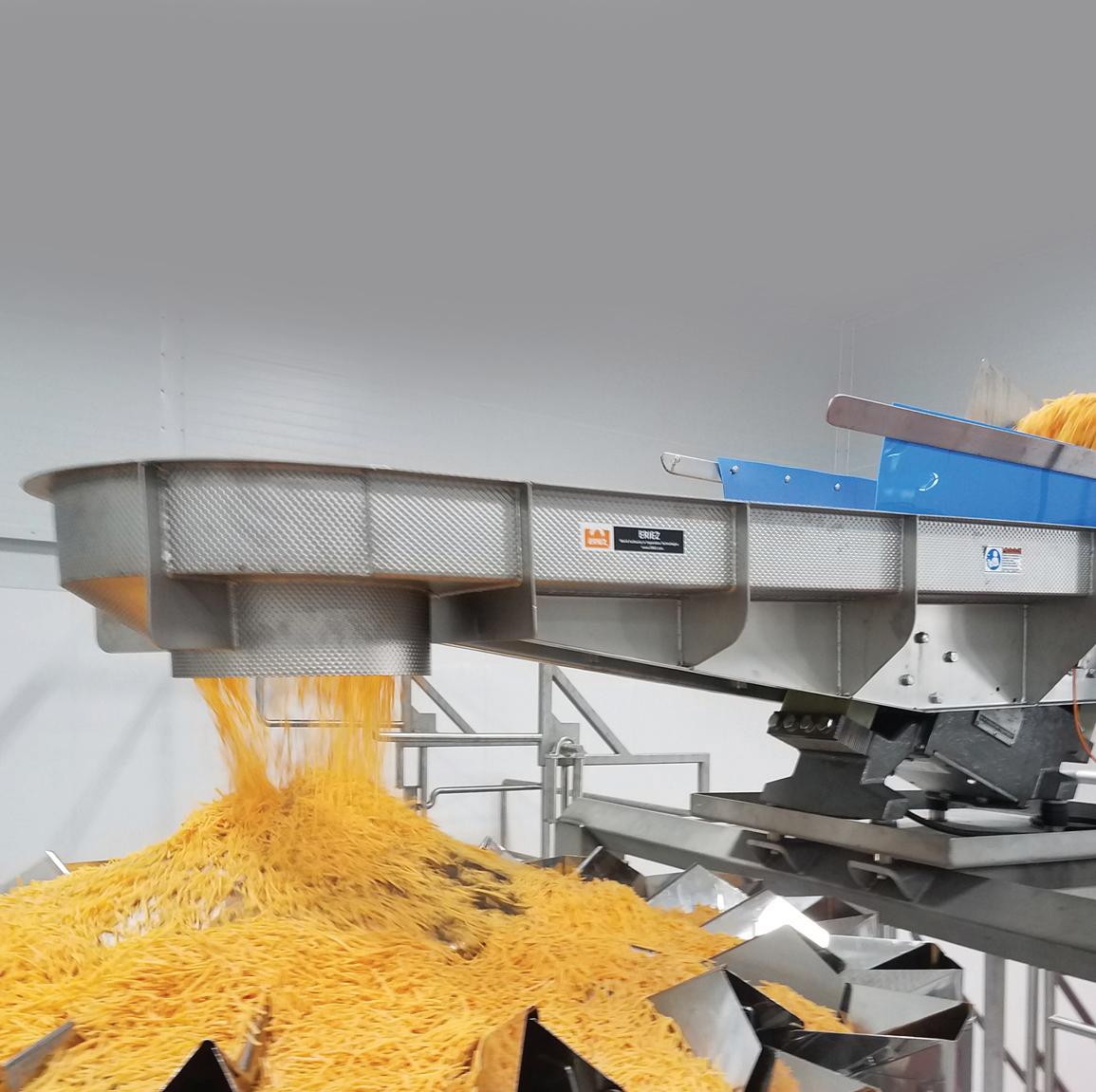
With 100% more capacity (45 tph) and twice the available tray size/mass than our next largest feeder, Eriez high capacity 76 Series Electromagnetic Vibratory Feeders are designed for packaging applications with high head loads or needing exceptionally long overhang.
•Handles high head loads
•Exceptionally long overhang

•Up to 45 tph
•High speed and high deflection drives

 ANNE MARIE MOHAN | SENIOR EDITOR, PACKAGING WORLD
ANNE MARIE MOHAN | SENIOR EDITOR, PACKAGING WORLD
GOING FROM ROUND TO SQUARE for a new version of its Easy Baking Tub for Domino Sugar and C&H Sugar, brand owner ASR Group has not only improved consumer convenience, but also reduced the package’s use of plastic by 28%. The tub, which holds 3.5 lb of product, or eight cups, is also recyclable and reusable, with home bakers encouraged to refill the package once empty with Domino Sugar and C&H Sugar sold in bags.
Suzzette Arroyo, director, brand management for ASR Group, confirms that convenience and sustainability were the primary drivers for the switch from the previous package—a round, high-density polyethylene tub with detachable low-density polyethylene lid—to the new square, polypropylene canister with attached, click-toclose polypropylene lid.
“We are always looking for ways to be more sustainable to be at the forefront of the sugar industry,” Arroyo says. “Domino and C&H Sugar are committed to making 100% of their packaging renewable or recyclable by 2025. Therefore, we are excited to launch a new version with a design that includes a hinged lid that makes it easier for the consumer to open and close. The new tub facilitates accessing and measuring the sugar
because the lid can be used for leveling in the measuring cup to ensure the perfect amount without the hassle of using a utensil to level the sugar.”
During initial exploration of the new design, ASR Group’s packaging engineers worked with several suppliers, ultimately selecting Mauser Packaging Solutions to develop the new tub.
According to Courtenay Cooper, principal packaging engineer for ASR Group, the 28% reduction in plastic is the result of the overall difference in the shape of the tub, its wall thickness, and the way that it’s processed.
The square Easy Baking Tub measures 6.625 × 5.5 × 5.125 in., and is decorated with a full-wrap in-mold label, with package graphics adapted for the new shape by Equator Design. As for the tub’s hinged lid, Cooper explains that it’s attached horizontally to one side of the tub to facilitate the opening and closing of the package. The pull tab on the lid functions as tamper evidence. When the pull tab is removed, it leaves about one-third of the lid fully attached along the tub’s width, which enables the remaining portion of the lid to be opened to access the sugar.
Another significant sustainability feature of the new container is the fact that it is nestable, which the round tub was not. According to Arroyo, because more tubs can fit on a truck, the carbon emissions resulting from transportation of the empty packaging to ASR Group’s production facility are reduced by 65%.
The new tub is also fully recyclable, as was the round package. However, ASR Group has increased the odds that the new package will be recycled by adding the How2Recycle label to the pack. To get the message out about the reusability of the container, Arroyo says ASR Group is collaborating with influencers as well as using its social media posts and social paid ads.
Domino Sugar in the new square Easy Baking Tub can be found at retailers across the Eastern U.S., while C&H Sugar in the new package is available in the Western U.S.
256 colors
Individually selectable:
Measurement in progress
Sensor switching
Process malfunction
▪ Completely flush sensing element

▪ Works on pastes and viscous media
▪ No spray cleaning shadows
▪ Very small installation dimensions
SUSTAINABILITY EXCELLENCE IN MANUFACTURING AWARDS









Whether getting help from an energy company, environmental organization, or government entity or engaging employees to develop resource-saving ideas, it’s clear that working together gets the job done.









AS A GROUP, food and beverage processors tend to be tight-lipped when it comes to sharing the whys and hows of their production advances. But the latest trade secrets in sustainability seem to be the exception to the rule—manufacturers are more apt to share these pre-competitive ideas to help the industry overall meet environmental and resource savings goals.
The topic of sustainability has steadfast competitors like Anheuser-Busch and Molson Coors sitting down over breakfast to talk about the one thing they’re still allowed to discuss. It has Keurig Dr Pepper working not only with ADM on regenerative agriculture, but also with competitors like PepsiCo. “It’s the great thing about the sustainability space— we can even work with competitors,” said Melanie Condon, KDP’s director of sustainability, at the latest BevTech conference.
Each year, ProFood World recognizes projects and programs undertaken by food and beverage operations. If there’s one thing that shone through with this year’s entries for our Sustainability Excellence in Manufacturing Awards, it’s how big a role collaboration plays in achieving sustainability goals. Getting financial support from energy companies or local government agencies is often instrumental to pursuing goals. There are environmental groups that companies work in collaboration with.
Perhaps most important of all, these projects require collaboration with your employees. Get them engaged, and they’ll come up with some of the simplest yet most e ective plans for process improvement.
You might notice that, whereas in the past we’ve typically awarded three winners in each the Program Category and Project Category, this year the shift has been almost entirely toward the project side of things. It might be an anomaly, but it creates a sense that companies are having significant success just chipping away at sustainability issues. Even the smallest changes highlighted in the following pages are seeing significant returns.
At the Food Northwest show earlier this year, Zach Podell-Eberhardt of Cascade Energy talked about the importance of saying “and” rather than “or.” Take on the small projects in addition to larger projects. The small ones will help provide the cost-e ective, quick returns to help fund the bigger stu . And—while moving on to the larger projects, don’t forget to keep up with the smaller ones to make sure they continue to work the way you first intended. With attention, they will continue to fund your projects moving forward.
All entries were judged by a team of food industry peers. The winners will be honored at a special session at PACK EXPO Las Vegas on Sept. 11.

In June 2022, Evol became the first brand to introduce Carbonfree Certified Carbon Neutral single-serve frozen meals. Part of Conagra Brands, the eight Evol meals are produced at the company’s TRUE certified Zero Waste facility in Fayetteville, Ark.

This latest certifi cation achievement is part of an ongoing e ort from Conagra, which has long prioritized impactful recycling and waste
reduction measures. Being a TRUE Zero Waste facility means the Fayetteville plant has diverted an average of 90% or greater waste from landfills or other waste reductions in the past 12 months. Tracking waste intensity (lb waste/lb production), the Fayetteville location achieved a 90.5% diversion rate, diverting 17,351 tons of waste from the landfill through recycling, organic diversion, and food donation.
There are other sustainability e orts in play as well. “All of Evol’s paperboard cartons are fully recyclable. The tree fiber used for the cartons is responsibly sourced, certified to the Sustainable Forestry Initiative. Evol also made the switch from 100% plastic bowls to paper-based bowls, which lowered the carbon footprint of packaging across all products. Ingredients across the line include chicken, beef and pork raised without antibiotics and no artificial colors or flavors,” notes Emily Muth, director of sustainability supply chain for Conagra.
“Fayetteville is Conagra’s first ever TRUE Zero Waste certified facility, and our team is currently evaluating how we can grow and continue our support of innovative waste reduction projects,” Muth says.
Progressive Processing, located in Dubuque, Iowa, and owned and operated by Hormel Foods, makes Hormel Compleats microwave meals, bacon toppings, and Spam products. Production professionals at Progressive Processing are always looking for ways to reduce water usage, and their latest e ort makes use of reverse osmosis concentrate (ROC) water.
With approval from a water-chemistry consultant and the Hormel Foods Internal Thermal Processing Authority group, the Progressive Processing team verified that ROC water could supply the operation’s retort process control in place of cold soft water. Changes were then made to the plant’s plumbing to allow the ROC water, a byproduct of boiler feed water, to be used in the retorts to replace the use of cold soft water.
“Retorts cook most of the food produced at the facility, and a large amount of cold soft water was used for non-food-contact process control,” explains Randy Thole, manager of plant engineering for Hormel Foods. “Reverse osmosis filtering is used to treat the makeup water, which the boilers turn into steam, and the steam is used in the retorts.”
Progressive Processing, owned and operated by Hormel Foods, was able to use reverse osmosis concentrate water in its retort process control in place of soft cold water.


PACK EXPO LAS VEGAS 2023 (Sept. 11–13, 2023; Las Vegas Convention Center) is taking the lead in highlighting the importance of sustainability in the industry. Debuting at this year’s show, Sustainability Central will take an expansive look into packaging sustainability and what it means to brands, including expert speakers, interactive content, and a look at actionable sustainable solutions in manufacturing, materials, recovery, logistics, analytics, and design. At the Sustainability Stage, attendees will hear from industry experts on a range of packaging sustainability topics and learn how to make their brands more sustainable.
PACK EXPO Las Vegas will showcase over 2,000 suppliers o ering cutting-edge packaging and processing solutions and innovations for more than 40 vertical markets. Exhibitors showcasing sustainable solutions via new materials, technology, or strategies such as sustainable processes and machines, renewable and biodegradable packaging, source reduction and lightweighting, recyclable and recycled-content materials, or innovations that reduce carbon footprint are easily identified with a PACK EXPO Green icon. The PACK
EXPO Green icon also highlights educational sessions focused on sustainability.
Additional highlights at PACK EXPO Las Vegas demonstrating the show’s commitment to sustainability include:
■ The Reusable Packaging Association will once again sponsor the Reusable Packaging Pavilion featuring exhibitors o ering reusable transport packaging to help attendees move their products e ciently, e ectively, and sustainably.
■ The Reusable Packaging Learning Center will feature presentations and panel discussions on a variety of topics related to sustainability and reuse.
■ PMMI Media Group has created the PACK EXPO Sustainability Solutions Finder, a targeted curated list of sustainable solutions exhibitors will be displaying at the show. Visit sustainability.packexpo.com to learn more.
For more information on all the show’s sustainability features, visit www.packexpolasvegas.com/green. For complete information on PACK EXPO Las Vegas and to register, visit www.packexpolasvegas.com.


100% polypropylene brushes built to tackle a wide range of cleaning tasks. Heat-fused fiber eliminates fallout and area for contaminants to collect.
Brush


Heavy Sweep
Stiff brush fiber excellent for sweeping coarse material from rough surfaces, concrete, and blacktop.

Light Sweep
Frayed brush fiber excellent for sweeping fine material from smooth surfaces, vinyl, marble, and terrazzo floors.
The pioneers of heat-fused brushware and your trusted supplier of cleaning tools for critical manufacturing environments.

The 2022 Sustainability Excellence in Manufacturing Award winners will present more details on their green projects at a special session during PACK EXPO Las Vegas. Join us on Monday, Sept. 11 at 4 p.m. at the Processing Innovation Stage—Booth N-10511 in the North Hall of the Las Vegas Convention Center. Register now at www.packexpolasvegas.com.
ProFood World wants to hear about your current sustainability projects. The submission deadline and eligibility requirements for the 2023 Sustainability Excellence in Manufacturing Awards will be announced this fall at pfwgo.to/sema.
The first phase of the ROC project was implemented in August 2022 on the existing retorts and the final phase in December with the installation of additional retorts. The project reduces water use by about 7.28 million gallons per year. Facilitywide, this is a reduction of about 8% for water use and 10% for wastewater.
“The project is self-sustaining because there is a direct correlation between the amount of steam used in the retorts, ROC water generated, and water needed for process control,” Thole notes. “This process could be transferred to other facilities that have both reverse osmosis filtering systems and steam retorts.”
Although a larger distance between the reverse osmosis filter and steam retorts could cause issues for use in other facilities, there is also potential for ROC water to be used in other heat transfer applications.

Steam traps are a significant source of water and energy use, and proactively addressing potential leaks can create more sustainable operations.
Conagra Brands’ facility in Imlay City, Mich.— known primarily for its Vlasic pickles brand—set out to review and optimize its steam traps to reduce steam and water loss, which has the additional benefit of carbon emissions reduction associated with that process.
After an initial analysis by a third party, the Imlay City facility identified 12 trap assemblies with improvement opportunities. With new steam traps, the independent assessment determined that nearly 139,000 gallons of usable boiler feeder water could be saved each year and carbon emissions associated with the 12 steam traps have the potential to be reduced by 78 tons per year.
“Steam has become the new green source for power and heating if controlled and utilized properly,” says Raju Markose, Conagra’s environmental manager in Imlay City. “Keeping a consistent record of the performance of steam traps can increase the system’s reliability and functionality.”
With this in mind, the Imlay City facility installed hardware that gives maintenance the ability to change a steam trap on the system without having to take the system out of production. “The new pipeline connector has a block and bleed function that allows the team to isolate the trap and bleed o the pressure, change the trap, and re-enable the system with full functionality,” Markose says. “This will shorten the time needed to replace traps in the future and also is an increase in the safety factor when servicing the steam system in general.”



Production Employee Idea Cuts Food Waste on Bob’s Red Mill Line by 70%
The Pacific Coast Food Waste Commitment (PCFWC) calls on food businesses and government entities to work collaboratively toward a goal of cutting food waste in half by 2030. Bob’s Red Mill was the first food manufacturer to join the voluntary agreement, setting to work to reduce food waste in its own operations.
With help from PCFWC and TripleWin Advisory, Bob’s Red Mill developed a multi-faceted employee engagement campaign to reduce food waste in the company’s whole grain milling and packaging facility in Milwaukie, Ore. Hosting a Food Waste Reduction Challenge, the manufacturer asked its employees for ideas on how to reduce food waste—from milling to packaging, to innovation, receiving, and quality.
“We started by asking, ‘Where is food wasted today that could be saved or prevented?’ We were impressed with the engagement from our employee owners, who submitted 176 creative, innovative food waste reduction ideas,” explains Julia Person, sustainability manager for Bob’s Red Mill. “We tested one reduction idea and implemented a change to a whole grain packaging line.”
The result: a more than 70% reduction in wasted food per pound of food packaged, on a single production line.
Following three months of the education campaign—incentivizing idea submissions, sharing a food waste educational video, and bolstering employee buy-in around reducing food waste— Bob’s Red Mill chose one employee suggestion to run as a five-week pilot.
The winning project idea, submitted by production employee Jennifer Blasko, focused on reducing grain spillover on a line producing granola products as well as pulse/whole grain products such as green lentils, split peas, and pearl couscous. It called for a method to better regulate grain flow, and implementation of the plan reduced food waste by more than 70%.
To conduct the pilot on the production line, a baseline was first measured. The maintenance team then made an adjustment to the line to reduce grain spillover from a conveyor belt by maintaining a metal screening tool that controls grain flow more regularly. The post-implementation measurement period ran for three weeks, to show the amount of food waste produced after the fix.


Food waste was collected in a dedicated tote, enabling the company to measure the improvement.

The post-implementation food waste audit showed an average 71% reduction in food waste per pound and 78% reduction per case for each product produced on the line. For granola products, it was 15 lb of product saved per pallet produced, and for pulse/whole grain products, the change saved 110 lb of product per pallet produced.
With a relatively simple change needed—requiring just a few hours of maintenance time, with a total cost of about $500—the ROI was almost immediate, Person says.
“The pilot shows how one simple employee idea can translate into impactful environmental savings,” Person says. “Food waste savings translate to avoided carbon emissions as food is able to make it into the hands of customers, rather than being wasted.”
The PCFWC supported the pilot, and a key outcome of the project was to share results with other manufacturers—through both a published case study (pfwgo.to/bobs) and a presentation at the PCFWC Manufacturer Summit.


Designed with economy, efficiency and hygiene in mind, the IQ cryogenic freezer offers continuous high throughput on a broad range of foods with easy clean up. Ten-foot modular sections make it field expandable with a minimal capital investment. A SMART remote monitoring system allows for trouble shooting from afar.
Increase your IQ and profits . . . visit airproducts.com/IQ or call 833-NEED-GAS (833-633-3427) tell me more









































































Camera Installation Helps Smith eld Avoid Plastic Film Waste in Ham Steak Packaging Smithfield Packaged Meats, in Kinston, N.C., has a company-wide goal of 75% Zero Waste to Landfill. Because of the di culty finding plastic recyclers in the area, an important part of that goal is to find ways to prevent plastic waste in the first place so that it doesn’t end up in the local landfill.



“A large amount of the solid waste generated at the Kinston plant is plastic waste,” says Charlie Prentice, environmental coordinator for Smithfield Packaged Meats. “This waste fills up our two compactors and requires us to have them pulled numerous times per week at less than the maximum fill weight.”
Smithfield’s winning project focuses on reducing that plastic waste, in this case from its Bone-in-Ham Wet Pack area, where the company runs steak lines. The steaks are cut from the center of hams, and then a conveyor carries the steaks to the pack machine, which is loaded with plastic film to create individual pockets. Employees place one ham steak in each pocket, and then the machine covers the pockets with preprinted film and seals the steaks for boxing.



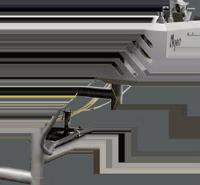
















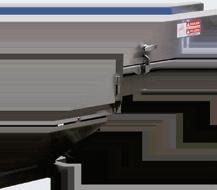









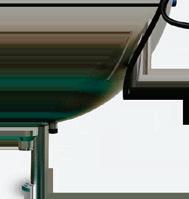
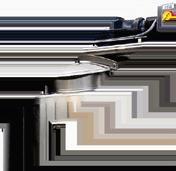











































“At times, employees were not filling all the pockets before the machine advanced. This could be due to line speed, fatigue, or inexperience,” Prentice says. “When these pockets are not filled, the wasted plastic/film from those empty pockets is collected as trash and sent to the landfill.”


The solution that Smithfield settled on after talking with contractors was to install cameras above each line. If the camera detects any empty pockets, it does not let the line advance until all pockets have product in them.
























“This system greatly reduces plastic/film waste,” Prentice says, adding that it also reduces the number of times each week the compactors have to be pulled. This not only reduces the amount of plastic sent to the landfill, but also reduces the fuel burned by the hauler.
Since production rates change from year to year, the facility used the variance report to determine cost savings, but a moderate estimate of film waste reduction so far is 75%, Prentice says, providing an
Once cut from the center of hams, steaks are placed in individual pockets. By installing cameras on the line, Smithfield Packaged Meats has been able to reduce its plastic/film waste by about 75%.


ROI of just under a month. The cost for the three cameras was $18,000, but the facility expects to save about $167,000 in forming film each year along with more than $2,000 in landfill costs.
The cameras were basic plug-and-play models, making it easy for the maintenance department to install and operate. The key concern was how to hang the cameras on the equipment. A mounting system had to be fabricated and installed over the equipment to center the camera. Stainless steel pipe was bolted to the floor and the piping raised enough to provide the height and centering needed and also keep it out of the way of production employees and nighttime sanitation crew.
As a greenfield plant, SunOpta has been able to take the best of everything from its three other plants and improve them further—from efficiencies and sustainability to sanitary design and safety.

WHEN SUNOPTA HIT CAPACITY LEVELS at its existing manufacturing facilities, it was time to establish capabilities in a new plant. Despite the company having looked at 180 possible site locations, today it’s hard to see Midlothian, Texas, just outside of Dallas, as anything but a foregone conclusion for the company’s next aseptic manufacturing plant.
“We were super happy with our choice of Midlothian because, not only has the city been great to work with, they have really helped wel-
come us into the community. The incentive packages we got were phenomenal,” says Chris Whitehair, vice president of operations. “Our hiring fairs have been super successful, and the caliber of folks we’ve been getting has also been very good.”
Approaching the facility in Midlothian, the town’s growth is apparent, new facilities and residential areas popping up right and left. In fact, Whitehair suspects it would be difficult to get the incentives today that they managed to secure for the site two years ago. SunOpta successfully negotiated with the City of Midlothian and Ellis County for a property tax abatement worth $7.5 million and $500,000 in operation grants contingent upon commencing operations and maintaining full-time jobs.
The plant’s specific location within the U.S. was strategic as well, creating distribution efficiency along with SunOpta’s plants in California, Minnesota, and Pennsylvania. “We’ve got one on the East Coast, one on the West Coast, a third one in the North, and Texas becomes a nice diamond shape,” says Anil Neti, senior plant manager. “Which will help in reducing 15 million miles per year, which equals 59 million pounds of carbon emissions.”
The location also places the co-manufacturer close to important existing and new customers. “One of our largest customers really wanted us to have aseptic manufacturing here,” Whitehair says, referring to a large coffeehouse chain for which SunOpta makes tea. “So that’s really what propelled us to come here and build this plant two years ago.”
Although the broths, teas, and plant-based
milks that will be made at the Midlothian plant are many of the same products that are made at its existing plants—and rely on much of the already-trusted Tetra Pak equipment for aseptic production—this greenfield project enabled SunOpta to optimize production, improve the flexibility of its systems, and accommodate new product lines, including 330 mL protein drinks.
That’s where the new customer comes in. The first phase of the buildout is targeted largely at Premier Protein single-serve nutrition drinks, with the capacity to produce about 78 million gallons of product per year. When we visited SunOpta in May, the line dedicated to the drinks had just been running for eight days. Premier Nutrition has one of its largest distribution centers in Arlington, Texas, also in the Dallas area.
The big driver pushing SunOpta to create more plant capacity in the first place, however, came largely from the plant-based milk market. COVID19 created a run on many key household supplies like toilet paper and hand sanitizer. But it also kicked off a boom for many of the more shelf-stable
foods in our lives. For SunOpta, this was perhaps most felt in the oat milk market that it served. By spring of 2020, sales of oat milk had skyrocketed 477% over the previous year, according to Nielsen data. Though a particularly significant surge during lockdown, the general trend toward plant-based dairy alternatives was already taking place and is expected to continue. SkyQuest technology foresees a 10.4% rise in the market from 2022 to 2028.
“We’re expanding the current portfolio—whether it’s oat milks, broth, tea, increasing the revenue there—but adding a new 330 mL Premium Nutrition to the bottom line,” Neti says. “That’s a whole new add to SunOpta, which is an incremental revenue to what we’re doing today.” That’s business that SunOpta would not have gotten without moving to this key Texas location.
A key consideration in choosing SunOpta as a Manufacturing Innovation Award winner came in relation to its innovative solutions to some pretty hairy supply chain obstacles while staying on a tight timeline.

Though staying on schedule—and on budget—is important for any project, SunOpta had a particular need to get this manufacturing plant up and running quickly. To secure the business of its new customer, the co-manufacturer had to be ramped to full production within 18 months of design concept.

SunOpta had kicked off its search for a site in September 2020, whittling its choices down to six finalists and then ultimately choosing the Midlothian site. By April 2021, the development team had chosen its design concept and presented its business case to SunOpta’s board. Construction began in September 2021.
“And then 16 months later, we actually made
first production, which was pretty remarkable,” Whitehair comments.
Having salable product by end of 2022 was no easy feat, and it required fast and creative thinking from the team at SunOpta and long-trusted partners Dennis Group (for design and engineering) and Tetra Pak (for aseptic production systems). Already quite familiar with the kinds of equipment delays that had become all too prevalent since the start of the pandemic, the team made a point of planning ahead.
“One of the things we did smart was we ordered long-lead items like steel and electrical components—anything that we thought was going to be a problem getting delivered coming out of COVID and the supply chain challenges—we got on it and ordered it,” Whitehair says. “That helped a lot.”
They could never have made the 16-month project delivery date without pre-ordering some bigger items in particular, Whitehair says. “We ran into challenges on deliveries every week,” he adds. “There wasn’t a week that went by—from the time we broke ground until the end—that there wasn’t something that we had to work through to get delivered on time.”
The main switchgear for the plant was one of those items, but that pre-planning wasn’t enough— timelines for electrical equipment just continued to grow, and the switchgear’s delivery date was pushed back time and time again. If they were going to have the plant operational by the end of 2022, they would have to pivot and come up with an alternative plan. Finally, they were able to find refurbished switchgear to use instead. Because the bottom conduits wouldn’t line up with what had been planned initially, the team had to quickly—within the span of a week— design and construct a platform for the refurbished switchgear to sit on in order to line up ports.

It’s a good thing SunOpta stopped relying on the original switchgear order to arrive. During our visit in May 2023, they were still using the refurbished equipment. The switchgear had recently arrived but was sitting to the side with missing components. “When this showed up, the parts were all missing,” Whitehair says. “Literally, 76% of the parts that were supposed to be in these were missing.”
Commissioning was also accelerated to keep the project on schedule. One solution was to ship the motor control centers while they were only partially constructed and to field install the remainder of the components.
Since power was limited throughout construction, utility systems had to be powered up strategically. Power to equipment was required for I/O checkout and initial function tests. The team would create punch lists and then power the equipment

A reverse osmosis system installed for ingredient water is also used to supply feedwater to the steam boilers, reducing blowdown of chemically treated hot water.
down, moving to the next equipment while completing the punch lists, and finally returning to complete I/O checkout upon completion of the punch list. This process was repeated for all the utilities to drive schedule and allow utility systems to be available to Tetra Pak systems for their checkout and functional tests.
On the construction side, delays resulted in the building shell dry-in date being several months later than expected. To keep the project on schedule, all parties committed to doing whatever they could to compensate for the delays, including extended hours, seven days a week. Whitehair says 300+ contractors were on site daily throughout the project.
Neti gives credit to the entire team for the creative solutions along the way. “It is such a great team that thought outside the box,” he says.
“Whether it is the gas, whether it is the power, whether it is the wastewater, you name it—every single one has been a challenge on this project. However, the team did a phenomenal job.”
There were a lot of people looking at answers to questions from every angle and coming up with new solutions to problems. “With SunOpta’s project management, the leadership—all the way from top down—helped in enabling us to be on track,” Neti adds.
Although the 285,000-sq-ft facility in Midlothian runs many of the same products as its predecessors, it has some advantages. With the new ground-up project, SunOpta was able to assess best practices at its other facilities and make improvements that might not have been possible previously. It also gave SunOpta the opportunity to add new product lines, with the flexibility to expand into new formats in the future.

“We spent months in the design phase on how we were going to lay out this plant,” Whitehair says, mentioning extensive work with Tetra Pak and
Dennis Group through several large projects over the past three years. “All of the things that we wanted to improve on got built into Midlothian—whether it’s sanitary design, whether it’s sustainability practices, whether it’s safety of our employees. Everything really got built into the design.”
SunOpta has used Tetra Pak equipment at its other facilities, but a greenfield space enabled the company to make improvements, many in worker comfort and safety. “Along with our sister facilities, feedback was taken from all their floor operators: What would you like to see if we built a new plant? That was incorporated into this design—whether it’s the restroom, whether it’s the mother’s room, whether it’s bigger spaces in the processing area, filling area,” Neti explains. “We’re going towards not just building and running product, but is it employee-friendly? Is there enough room and a comfortable room to make things. Those are all part of the design.”
Upgraded employee amenity areas included a larger locker room footprint to avoid crowding during shift changes, as well as an expansive break room with comfortable seating and a quiet area for phone calls or relaxing, as well as access to a prayer room and mother’s room.
The batching rooms were built larger to allow easier transfer of raw materials via drums or pallets. Equipment layouts provided more space so that operators are positioned further away from steam or chemical residue. Cooling drops were added above the operator stations in high-temperature areas. Additional space was also designed behind the fillers so that multiple operators could remove laminate off
Congratulations
When sales of oat milk surged during the pandemic, long-time sustainable food & beverage leader SunOpta stepped up to the plate with an innovative new facility to sustainably increase plant-based milk production. But this facility won’t just produce oat milk – the energy efficient design brought to life by Dennis Group will help reduce 59,000,000 pounds of carbon per year. It’s a winner in more ways than one.


Congratulations to the project teams on their success!

dennisgroup.com
info@dennisgroup.com

+1.888.514.7270
United States
● Canada
● Brazil
● Portugal
pallets without interfering with each other.
SunOpta also improved the location of its control rooms. The new plant has three separate control rooms—one for mix, one for processing, and one for filling. “They’re very close so the employees can go into the control room, do their work, and then only operate the equipment when they need to, and they can come back to the control room,” Neti says.
“We tried to make it as user-friendly as we could just by laying out the plan properly. We even have small satellite labs, even for our truck bay, where we receive materials. They have a lab out there, so they don’t have to walk 200 yards to another lab to test the products before we accept them,” Whitehair adds. “The flow of the plant—from ingredients coming in on the east side, finished goods going out on the west side, and all the mixing, processing, and filling that goes on in between—it’s just a very natural flow of the plant from east to west. For this facility, we were able to do that because we were starting with a blank sheet of paper.”
The Texas facility has a two-lane bay where various liquid product bases are received, sampled, tested, and then transferred to refrigerated silos
with agitators. Liquid sweetener is also received and transferred to a heated jacketed silo with an agitator. Exterior air into the tank passes through HEPA filters and a UV disinfection chamber to avoid contaminants or bacteria from being introduced.


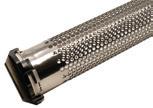





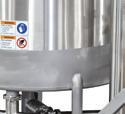
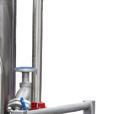
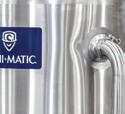

These silos feed two Tetra Pak high-speed aseptic production lines that are flexible enough to produce more than 100 SKUs for SunOpta’s diverse customer base. Batch systems are completely automated for bulk ingredients, while minor ingredients are added manually. Once batched, the product is thermally processed with direct or indirect steam. Depending on the product, the packaging formats include slim liters, edge liters, and 330 mL single-serve beverages. Robotic palletizing is used before product is transferred to the finished goods warehouse, which typically holds five weeks of inventory.

Hygienic finishes are used throughout the production space, particularly in high-care areas, including a walk-on ceiling, insulated metal panel (IMP) walls, stainless-steel finishes, and sloped drainage. Mix-proof valves enable SunOpta to take any system down for sanitation or service, while other systems remain online.
“We leveraged the Dennis Group, who are very




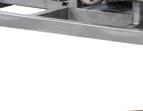

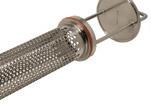



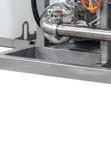
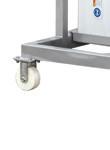

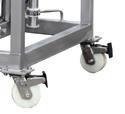

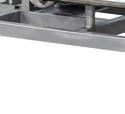

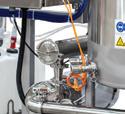


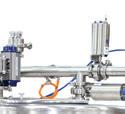
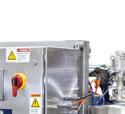


Wastewater capabilities in the area couldn’t handle what the new facility would produce, so SunOpta’s employees are operating the site’s own wastewater treatment plant.

familiar with food sanitation construction, and we leveraged the best practices that they could bring to this design—on floors, walls, ceilings, even how to design a drain properly,” Whitehair says, listing a slew of good sanitation practices.
A lot of investment went into the SunOpta cleanin-place system, Neti notes, including an increased level of automation for several of the tasks. “It’s an automated system to clean the tanks, the lines with the right temperature, right duration, right concentricity, right chemicals in there—a lot of it is automated, so it’s less chance for a mistake to happen.”
SunOpta has standardized on Tetra Pak equipment on all of its lines at all of its plants, using Tetra Pak controls, and Tetra Pak technicians helping to maintain the lines and train employees on their use. The location of the new plant has also been helpful when it comes to working with Tetra Pak, which has a state-of-the-art factory also in the Dallas metro area, in Denton, Texas.
The production systems use Tetra Pak’s Plant Master control system, so Dennis Group integrated each utility with the proprietary system. Utilities communicate with the Tetra Pak programmable logic controllers (PLCs) so that the system calls for tower water only when needed, which is more energy-efficient. Utilities also have monitoring to alert when there is an issue.
Most of the equipment at the plant is PLCdriven, with the drives, PLCs and supervisory control and data acquisition (SCADA) system all communicating with each other, Neti notes.
SunOpta’s Texas facility is using Redzone software extensively to manage several aspects of information and communication within operations. “It takes some of this information, compiles it, and ensures, for example, what speed are we running a
 PHOTO COURTESY OF SUNOPTA
PHOTO COURTESY OF SUNOPTA
certain line? How many packs did we run? What’s our OEE? What’s our downtime look like? What do our micro-stops looks like? That’s one piece of it,” Neti explains. “The second piece of it is the communication. We don’t necessarily have to go from an operator to a lead to a supervisor to a plant manager to know what’s going on. With the controls automation and the Redzone program that we have, it’s more like Facebook and Instagram combined. An operator can go in and type something in—it’s a high five or it’s a recommendation or it’s a concern. And then they all look at it at the same time.”
Operator training is an important piece of the Redzone software as well, Whitehair says, commenting about the ability to include short videos in the system, as well as manuals, all of which can be customized to an individual and their comfort level with various types of learning.
“The tool really engages your employees—the daily direction setting, the communication, getting them to feel comfortable because you’ve got these places to go to if you forget something. You can go and watch a short video even on your workstation or
The presentation of ProFood World ’s seventh annual Manufacturing Innovation Awards is planned for Tuesday, Sept. 12, during PACK EXPO Las Vegas.
Here are the 2023 winners:
n SunOpta—A new facility in Midlothian, Texas, is dedicated primarily to co-manufacturing plant-based milk alternatives, teas, whey-based protein shakes, and other beverages.
n Prestage Foods of South Carolina—The 295,000-sq-ft greenfield project in Camden, S.C., is a state-of-theart turkey processing facility that follows a European air-chill processing model.
n MyForest Foods—In Green Island, N.Y., the new vertical mycelium farm is the world’s largest of its kind, changing the way food is produced and looking to scale quickly for its MyBacon plant-based bacon.
Come hear discussion of all three award-winning projects on the Processing Innovation Stage at PACK EXPO Las Vegas. For more information or to register for the show, visit www.packexpolasvegas.com.
Look for plant profiles about MyForest Foods in the June 2023 issue of ProFood World and Prestage Foods in the upcoming December issue.
on your handheld tablet,” Whitehair says. Another piece of the software is maintenance, and also quality control. “All of our quality testing, all of that record keeping, will be done within Redzone,” Whitehair says. “It makes the KPIs, the training, the maintenance, and the quality a onestop shop and makes us a virtual shop floor. We built that into the design in the beginning, but we’re already rolling that out in our other plants.
The plant’s enterprise resource planning (ERP) is connected to an Oracle system, enabling tracking from farm to fork (or glass). “They’re all traced all the way from the time that we got the raw material and lot numbers, the SKUs, to which piece of equipment it’s going, whether it’s going into a certain tank, certain mixer, certain processor, certain filler line—all the way it’s traced and tracked,” Neti says. “For whatever reason, if things don’t go as well as they should, we would want to know what lot it was, how much did we make, which equipment it was made on. It helps significantly with troubleshooting and during the process.”
Though this traceability has in part to do with regulations around the Food Safety Modernization Act (FSMA), SunOpta aims to push beyond just compliance. “We also continue to try to raise the bar. Our customers are helping us to continue to raise the bar around food safety,” Whitehair says. “We’ll take best practices from an auditor—whether a customer audit or SQF audit or something we learn through the industry—and try to apply it in our plants. With aseptic, you have very little room for error.”
SunOpta estimates that its new strategic location in Texas will save the company 15 million freight miles annually and save 59 million pounds of carbon emissions. The plant itself is designed to reduce carbon emissions, conserve water, use power efficiently, and make use of recycled materials.
SunOpta purchased two cooling water skids from Tetra Pak so they could reuse water for cooling instead of disposing of it. When running at full capacity, the water reuse equipment will save close to 20 million gallons per year.
Utility systems throughout the plant were designed to be energy-efficient. A reverse osmosis (RO) system that was installed for ingredient water is also used to supply feedwater to the steam boilers. Using purified RO water for the boilers rather than a soft water system reduces blowdown of chemically treated hot water by about 900,000 gallons annually. The steam boilers have blowers equipped with variable-frequency drives (VFDs), which results in a higher turn down ratio by better matching the load for each individual batch. Both of the two steam boilers have an economizer to recover heat.







For over 60 years LPS® has earned a reputation for both quality and performance in critical industrial applications. LPS® DETEX® combines that expertise with food safety programs to produce a full line of maintenance solutions specifically formulated for food processing facilities.




LPS® DETEX® lubricants, penetrants, electronic cleaners, and greases save time and money by extending equipment life, reducing repair time, and lowering frequency of preventative maintenance.




Plastic components used to package LPS® DETEX® products are both metal & X-ray detectable, helping to reduce the risk of foreign object contamination within your facility.






































An ammonia-refrigerated cold glycol system was selected for both air handling and process cooling. Using a central ammonia refrigeration plant for building cooling is more energy-efficient than using individual freon-based air handling units. During periods of cooler ambient temperatures, the control system turns off the condenser water circulation pumps and modulates fan speed to save energy based on external conditions such as humidity and temperature. Larger condenser equipment was installed for the ammonia refrigeration system to lower the system head pressure. The speed of the compressors can be varied so the system matches process load for improved efficiency. A fully redundant ammonia compressor was also installed to avoid process downtime.




With all the new homes and businesses being built in the area, it was important for SunOpta to make sure that the facility had the electrical load, gas, and other utilities available for operation. Wastewater capabilities in the area couldn’t handle what the new facility would produce, so SunOpta spent about $6.5 million dollars on a wastewater treatment plant of its own. “If we hadn’t spent upfront to invest in our own wastewater treatment plant, we would not be running today,” Whitehair says.

The local water authority, a private entity called Trinity River Authority, had a wastewater treatment capacity of 3 million to 4 million gal/day (MGD) of domestic-strength wastewater at 150 mg/L biochemical oxygen demand (BOD). Since SunOpta’s effluent at 5,000 mg/L BOD was almost equal to the total capacity of the municipality, a full membrane bioreactor (MBR) system was required. The biological system






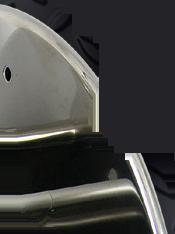










treats down to discharge-quality water, or less than 8 mg BOD per liter. The system, which can handle 240,000 gallons per day, will allow SunOpta to use reclaimed water for various purposes in the plant.

SunOpta also has an option to obtain a surface discharge permit in the future, completely removing any reliance on the limited capacity of the public wastewater system. The system has dissolved air flotation (DAF) for pre-treatment and uses a centrifuge for dewatering, which reduces the sludge to 22% solids. This method reduces hauling costs by about 85%. Bio solids are stored in bins, which further defrays hauling costs by reducing the number of trips.

“The investment made is also part of the social responsibility from a sustainability standpoint. The water we discharge today is as good as the water we have coming in, or better at times,” Neti says. “That takes a lot of money to invest to do that. But it fits into our SunOpta sustainability model to make sure we take care of the community, employees, customers, at the same time as the environment”
SunOpta purchased the 32-acre site in Midlothian with a view toward future expansion. The facility is currently running two lines but can easily double capacity without any building or utility expansions. As part of a longer-term plan, the site is suitable for another 150,000 sq ft of building expansion, and site work—including the placement of fire lanes and the wastewater building—were all designed around that.
At the same time that the new plant gets the advantages of a clean slate, it also has the advantages of corporate resources from existing SunOpta facilities. Whitehair points to the company’s large pilot lab at its headquarters in Eden Prairie, Minn., for example. “A lot of the front-end work can be done there, but we’re also taking the learnings from the other plants,” he says. “SunOpta can learn four times faster because we have four plants operating instead of just one. We’re constantly sharing best practices and learnings, either from our corporate pilot lab or the four other plants. I think that’s really helped us accelerate our improvements.”
The Midlothian plant has had buy-in at every level of the corporate organization. “Early on, when we told our entire company that we were going to spend $125 million on this plant, it was going to be every one of our jobs to make sure that this startup is successful. Having been here a lot for the last couple of years, you truly see it every day—whether it’s the people we can send to a plant to get trained, or the people who have come here to help provide support during startup or training,” Whitehair says. “It’s fun to watch that collaboration and sense of ownership that you get from every level in the company.”
For 100% product purity and safety solutions visit:










www.aerzen.com/en-us



























Increased interconnectivity and cloud-based systems bring sophisticated ERP software capabilities to small and medium-sized companies as well as the big players.
IT WAS NOT LONG AGO that using sophisticated software meant you had to be a large company with deep pockets. That’s not true today as software has become both more powerful and less expensive, putting it within reach of small and medium-sized companies as well.
Vendors are introducing new enterprise resource planning (ERP) software designed to enable food and beverage processors even in narrow market segments to quickly access the data they need to improve the e ciency of their operations.
“ERP software is constantly evolving, in no small part because the food and beverage industry is always evolving,” says Jack Payne, Aptean’s director of solution consulting for food and beverage. “Today, some developments are driven by new technologies, and on that front, there’s no topic that’s hotter than artificial intelligence (AI). We’re already seeing AI applications to help with optimized software setup and customized suggestions that could be incorporated into ERP solutions.”
Other developments are more trend-driven, according to Payne. “For example, ERP tools for reducing food waste and spoilage to drive greater sustainability are very popular right now, as are features that help businesses manage cost fl uctuations and infl ation,” he says. “Mobile accessibility has also become widespread among ERP systems, but now many are moving toward mobile optimization to improve that functionality.”
There’s also a general push toward greater interconnectivity between ERP software and other types of software, including business intelligence (BI) for indepth reporting and analytics, plus electronic data interchange (EDI) for transacting with larger clients. “And there are still more supplementary systems that can be integrated, including transportation management systems (TMS) for companies that distribute their own products,” Payne adds.
Other new developments crucial to the food and beverage industry include enabling real-time inventory tracking, in-depth analytics, and ERP to warehouse management system (WMS) integration, notes Jacob Olson, director of manufacturing solutions for Cleo. “These advancements are driven by ecosystem integration technology and the utilization of APIs to connect business systems and improve order management and fulfillment processes,” he says. “The ERP handles order management while the WMS takes care of fulfillment, creating a more e cient and streamlined workflow.”
Directly integrating both ERP and WMS into business processes such as inbound customer orders helps manufacturers better monitor and predict future inventory levels in real time, Olsen adds. “This integration enables companies to maximize the value of in-depth analytics and leverage business intelligence, Big Data analysis, data archiving, machine learning, and data science to optimize processes, develop e ective strategies, and plan for the future.”
Cloud-based systems are drawing significant interest today from both vendors and customers, in large part because they make it possible to deploy ERP to manage multiple processes and departments across the enterprise, explains Jim Bresler, product management director, food and beverage, for Plex by Rockwell Automation.
“Interconnectivity across enterprise systems and assets—enabled by cloud and IoT (Internet of Things) technologies—makes it possible to deploy supply chain management (SCM) and manufacturing execution system (MES) capabilities in an ERP system that provides a holistic view of supply



chain and procurement operations,” Bresler says. “This is critical, especially for large manufacturers and food processors with multiple facilities that need MES and ERP solutions with the ability to integrate production and inventory data with back-end systems. A unified ERP system provides end-to-end visibility across the enterprise.”

Ensuring regulatory compliance with U.S. Food and Drug Administration (FDA) requirements is a critical aspect of the cloud systems. “As a part of these requirements, manufacturers in the food industry need high levels of track and trace capabilities,” Bresler explains. “While most ERP solutions provide some level of traceability, across





inventories or production processes, food and beverage manufacturers need an ERP system that provides very granular levels of track and trace to meet regulatory requirements. This necessitates a cloud-based ERP solution that can integrate with back-end systems, such as MES and quality management systems (QMS), to pull data from across the enterprise and track ingredients and products from the point of origin to their final destination.”
Affordable and speedy cloud deployment, along with proven implementation templates, helps enable small and medium-sized processors to access the same features as larger enterprise manufacturers, according to Bresler. “This configurable system allows manufacturers to customize the workflow according to the company’s specific requirements, enabling smaller processors to avoid spending on unnecessary capabilities.”
These needs typically revolve around essential aspects such as track and trace, FDA compliance, hazard analysis and critical control points (HACCP), the Food Safety Modernization Act (FSMA), and production yield and cost management, Bresler adds. “While smaller and medium-sized processors may require less plant floor automation, it is common for them to have some level of automation in place, making integration with an MES system highly advantageous,” he says. “This means smaller processors can establish their minimum entry point to quickly return value, and gradually expand into more advanced enter-
prise-grade features if the returns look promising.”
Smaller companies often try to deploy ERP software in-house rather than in the cloud, which can have a negative impact on operational efficiency, according to Stephen Burton, founder and CEO of Icicle Technologies. “There is a lot happening in Big Data and AI, which can only be leveraged when data is shared securely,” he says. “Since legacy on-premise ERP software cannot leverage these advances without significant investments, cloud-based applications can often be more advantageous to manufacturers.”
Data volume is among the most important factors in optimizing the potential benefits from AI, Burton explains. “It doesn’t really work If you don’t have a broad enough database to be able to use AI effectively—to do smart mining of your data, to do things like we do, where we can identify what the biological, chemical, physical hazards are,” he says. “I think we’re only touching the absolute tip of the iceberg at the moment, and there’s going to be enormous advances that we can make on AI. But in order to have an effective deployment of AI technologies, you have to have a significant data volume, and these single one-off on-premise implementations are not going to be able to support that.”
Many ERP vendors are zeroing in on narrow segment focuses with their software in order to make it more effective than software designed for larger companies and broader purposes. Infor provides ERP support across the entire food and beverage industry, but does so by varying product features according to segment needs, note Marcel Koks and Mikael Bengtsson, food and beverage industry strategists for Infor.
It’s important to be industry-specific out of the box—even on the micro-vertical level—in terms of functionality, content, and reporting. “Equally important is to have an implementation team that understands the industry-specific challenges and how to address them,” Koks says. “At the end of the day, it is about generating real business value. To do that, a one-size-fits-all and never-ending project is not the solution.”
The right capabilities can turn a challenge into a competitive advantage. “It is extremely exciting to

Emerson’s IIoT solutions and analytics software detect compressed air leaks saving manufacturers over 20% in energy costs.
Learn more at Emerson.com/Sustainable-Automation

Visit us at Pack Expo 2023
South Lower Hall, Booth 6107
Batch processing requires different ERP capabilities than discrete manufacturing, particularly if goods are produced across multiple facilities.






see when our customers leverage our platform as a vehicle for transformation and innovation,” Bengtsson says. “For example, one of our customers just went live with a yield optimization involving artificial intelligence and machine learning, positively impacting their profitability.”
Batch hurdles


Batch processing presents a number of significant challenges for ERP software vendors, particularly when customers make the same products in multiple locations. “A food manufacturer will use one formula to produce their product in their North Carolina facility and since the water chemistry is different at their California facility, for example, they






use a different formula so the taste to the consumer will be exactly the same,” explains Jen Childress, director of marketing for Vicinity Software.
The same finished good could have two different SKUs depending on which facility manufactured it, so the ERP software needs to be able to differentiate facilities. “Most discrete manufacturing software does not support making the same item using different BOMs [bills of material]. This is because batch manufacturers are more affected by variation or availability to raw materials,” Childress notes. “The software should tie a formu-














la to a produced item by facility. This provides the needed flexibility for batch manufacturers.”










Yield analysis is another area of concern for batch processors, Childress says. “Many larger ERP systems are built for a model that uses repetitive assembly called discrete processing. You make the same item the same way every time. In discrete manufacturing, when you start back-flushing, the software says, ‘You made 100 of these products. That means you must have used a fixed amount of the components.’ It is all very fixed and organized. But that doesn’t work in our world of batch process manufacturing,” she says. “What will happen is that your raw material and inventory control will get out of whack because the bill of materials said you used 100 components, but you actually used 120 or 90. All of a sudden, that back-flush takes that variable yield and pushes it into inventory. Now, before you know it, you don’t know what materials you have, and you don’t know why. That linkage between what was supposed to be used and what was actually used can be really significant depending on the industry.”


Scheduling, according to Childress, is probably the No. 1 feature or technology that a manufacturer that grows from small/medium to a larger-sized organization needs. “While lot traceability is in place no matter the size, scheduling is not usually added until more growth is recognized,” she says.
Analytics of the quality and operational data also tends to come later on the growth journey, when companies can turn from their day-to-day operations to look more to process optimization. The ability to share data across multiple sources has become a priority. “The sharing of information across many sources of data—whether control systems, supplier or customer operations, or barcode data collection—has become essential,” Childress says. “The ability to receive information from one system, send it to yours, and then hand it back and connect the pieces together throughout the manufacturing process is big. This is already happening, but will happen at a much faster pace as the software providers (and even hardware providers) come together under common frameworks to increase the number of ways to communicate with each other.“












 MICHAEL COSTA | SENIOR EDITOR
MICHAEL COSTA | SENIOR EDITOR
The every-other-year event will feature several new and expanded segments aimed at food and beverage processors.
PACK EXPO LAS VEGAS returns
Sept. 11-13 to the Las Vegas Convention Center with even more innovative features and future-forward ideas for industry professionals since the last show in 2021. This year’s PACK EXPO Las Vegas promises to be the largest, most comprehensive edition ever, with 30,000 attendees expected, and more than 2,000 exhibitors across more than 970,000 net square feet of exhibit space.
Produced by PMMI, The Association for Packaging and Processing Technologies, PACK EXPO Las Vegas is the premier destination to see cutting-edge packaging and processing equipment and technology firsthand, with suppliers showcasing diverse options for more than 40 vertical markets, making it the most all-inclusive packaging and processing show in North America this year.
For food and beverage processors in particular, PACK EXPO Las Vegas 2023 has more offerings than any previous version of this show. Here are some of the must-see highlights to check out during the threeday event.

The Processing Zone returns to PACK EXPO Las Vegas double the size it was in 2021. The Processing Zone focuses on the integration of processing and packaging, a key function in the manufacturing environment. It’s a great place to start your search for front-of-the-line solutions such as homogenizing, heat treating, forming/sizing, and coating. Within The Processing Zone at PACK EXPO Las Vegas, visitors will discover tools to help increase
efficiency, achieve total system integration, and ensure employee safety.
You can see The Processing Zone in the North Hall of the convention center, within which you’ll also find the Processing Innovation Stage (located at Booth N-10511), which offers free show-floor education for industry professionals focusing on the latest breakthroughs in processing strategies and technology. No registration is required for Processing Innovation Stage sessions.
Stop by the Processing Innovation Stage Sept. 11 and 12 as ProFood World recognizes food and bev-
Attendees can get an up-close view of the latest industry innovations for food and beverage equipment at The Processing Zone, which returns to PACK EXPO Las Vegas this year double the size of the previous show in 2021.



















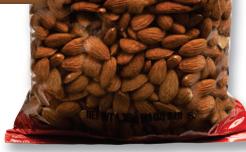


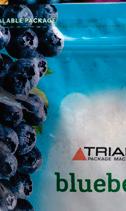





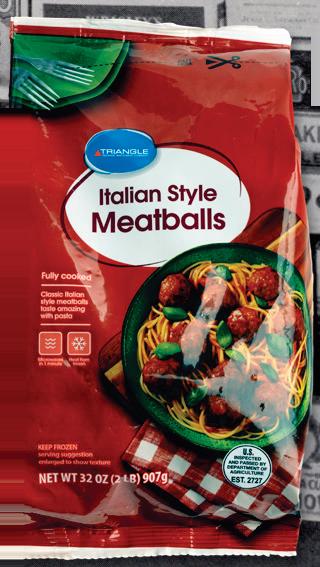


erage processors excelling in the areas of sustainability and manufacturing breakthroughs for 2023. On Monday at 4 p.m., Editor-in-Chief Aaron Hand will present our Sustainability Excellence in Manufacturing Awards to Hormel Foods, Conagra Brands, Bob’s Red Mill, and Smithfield Packaged Meats. Then on Tuesday at 4 p.m., we’ll give this year’s Manufacturing Innovation Awards to MyForest Foods, Prestage Foods of South Carolina, and SunOpta, with a reception to follow. Hear what representatives from each company have to say about their state-of-the art operations and what effective strategies they’ve put into action.
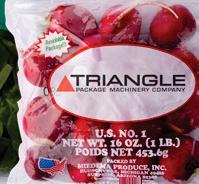















In the South Upper Hall, you’ll find the Confectionery Pavilion, featuring the latest trends relating to aeration, batch refining, shaping, cluster production, and other candy-making technologies. Sponsored by the National Confectionery Association (NCA), this pavilion provides an opportunity for attendees to network and gain valuable insights into candy processing.










Join the Packaging & Processing Women’s Leadership Network (PPWLN) for a breakfast event on Tuesday, Sept. 12, with award-winning entrepreneur Manjit Minhas. A petroleum engineering student turned beer baroness at age 19, Minhas co-founded Minhas Breweries, Distilleries and Wineries—becoming the youngest brewery owner in the world. It’s now the 10th largest brewery in North America. This PPWLN event is titled Brewing Success: How Manjit Minhas


VENUE: Las Vegas Convention Center, Las Vegas
DATES: Sept. 11-13, 2023
HOURS: 9 a.m.-5 p.m. Monday and Tuesday; 9 a.m.-3 p.m. Wednesday
REGISTER: www.packexpolasvegas.com

Turned an Idea Into a Beer Empire, and Minhas will explain how she broke into the highly competitive, male-dominated beer and spirits industry, and offer advice on ways to conquer obstacles and live the life of your dreams. This networking breakfast takes place 7:30 to 9 a.m. in room N-247.
After a successful debut at PACK EXPO International last year, the Emerging Brands Summit returns to provide the ultimate resource hub for fast-growing brands looking to scale their operations. Set to take place at the Westgate Hotel & Casino in Las Vegas Sept. 10—the day prior to the start of PACK EXPO Las Vegas—the summit features a dynamic agenda packed with educational sessions, expert panel discussions, and networking opportunities.
Attendees will hear directly from brands that have successfully scaled through both contract and in-house manufacturing, including representatives from Chomps, Danone, Pescavore, Mattson, Sarilla, and Yishi Foods. Those who attend the Emerging Brands Summit will receive free registration for PACK EXPO Las Vegas, which starts the next day on Sept. 11.

PACK EXPO’s annual event, PACK gives BACK, returns to PACK EXPO Las Vegas with an all-new format this year. On Sunday evening, Sept. 10, Cirque du Soleil will present a private performance of “O” at the Bellagio Hotel & Casino. Rockwell Automation is the title sponsor and proceeds benefit the PMMI Education Foundation. Doors Open at 5:45 p.m., and the performance starts at 6:30 p.m. Tickets are $95 available for single purchase or in blocks of 10 for $855, and include general admission seating and drinks/snacks at the theater.
WHEN SALES OF ITS fully cooked sausages began to outgrow capacity at its headquarter campus, Johnsonville found a new home in the recently vacated Wigwam Mills factory in Sheboygan, Wis. It took more than a year to transition from sock manufacturing to sausage production, but Johnsonville engineers wanted to make sure that the 190,000-sq-ft facility was fully equipped with state-of-the-art production capabilities.
An important piece of equipment that the sausage maker wanted to reevaluate for the new site was its cook/pasteurize and chill process. After being made, the sausages get packaged in a form, fill and seal machine. From there, the packages are run through the cook and chill process—after which, they run through a quality check and then are boxed for shipping.
Before beginning production at the new Sheboygan plant, Johnsonville was proving out



the concept of a cook and bake process, notes Matt Behrs, plant engineer for Johnsonville. “We had an inline cook/chill process that was very hard on our product, so it really bent it up and made it look terrible,” he says. “We were very challenged at coming out with a good-quality product using that system.”
The auger-style water bath unit tended to cause Johnsonville’s product to clump together, reducing water circulation on the product and causing inconsistent heat transfer across the product batch. To overcome the product clumping, the team looked at systems using agitation to maximize water circulation. But the product agitation, along with the use of an auger screw to push the product through the water, caused product package and label damage.
“Because it’s an auger inside there, it would come into flights and they would roll around each other—and they would literally move our labels around, and they would come out very crooked,” Behrs describes. “We had a lot of loss because of label misplacement after they went through the cook system.”
Product also did not pass through the auger system in a reliable first-in-first-out (FIFO) order.
The most hygienic and ergonomic solution available, MAXIMIZER RMI offers a perfect balance of accurate detection and targeted rejections to reduce waste and maximize yields, while the small footprint and modular design integrates easily into your production line. Advanced bone and metal detection with PXT™ maximizes product safety, enhances quality and reduces false rejects, further optimizing your process.

Drive productivity to the MAX with EaglePI.
“It’s basically a washing machine, so the product didn’t always come out in the same order that we put it in,” Behrs explains. “The ability to make sure our cook times are proper—not too long or too short—is very crucial to our process. So the ability to have first in first out is imperative, and the process we had did not give us that.”
The cook/chill concept, however, worked well, so Behrs and his team set out to find alternative systems to incorporate into the new production line. What they found was an FPS Spiral Immersion System (SIS) with an Intralox self-stacking belt.
With a large capacity of water (7,000 to 8,000 gallons in each of the heating and chilling tanks), the system provides a very consistent heat level, Behrs says. “And my product comes out exactly the way it went in,” he adds. “They’re coming in perfectly flat, they come out perfectly flat. We’ve been very, very happy with the outcome.”
Johnsonville had looked at similar systems from other companies, but FPS won out on value, availability, and efficiency. “Johnsonville is very good at looking at the new and innovation, and we’re work-
ing with a lot of equipment out here that’s serial number one or two or three, so we’re kind of used to that,” Behrs says. “The system that was proposed to us through SIS, we thought was one of those upcoming systems that we really wanted to get ahead of and really understand how it works. So that was our deciding factor.”
Installation of the SIS was completed in January
2022. The system has a capacity of 3,500 lb/hr. Johnsonville, “which is probably 500 lb/hr faster than we’ll ever go,” Behrs says, noting throughput limitations in downstream equipment.

Because the SIS was serial number two, Behrs says, it was not without its challenges in the beginning. “But the FPS group have been fantastic to work with. They’ve had people out here anytime we’ve had any issues, and they’ve worked through the issues,” he says. “My mechanics have gotten very versed in this, so we’ve been able to collaborate with their engineering to come up with some solutions that they now have in place on both of our tanks.”
FPS Food Process Solutions www.fpscorp.ca
 After packaging, Johnsonville sausages go through a cook/pasteurize and chill process before being put into boxes.
After packaging, Johnsonville sausages go through a cook/pasteurize and chill process before being put into boxes.
Designed to meet the demands of industrial refrigeration, the M&M Carnot compressor controller has a large panel-mounted PC touchscreen with a user-friendly menu structure and real-time, animated graphics. Utilizing the Windows-based PC Enterprise platform with an HMI interface, the V4 screw compressor microcontroller includes a multi-level security system with user tracking and provides isolated RS-422 communications. The controller is field-updatable with an industrial-grade USB port. V4 hardware is retrofittable into existing panels with minor software upgrades.

M&M Carnot | mmcarnot.com
With the Linde remote monitoring system, users have online access to freezer data to obtain realtime information and historic data for managing the ongoing performance of their cryogenic freezers. The Cryoconnect RM system uses operational sensors to collect the data and then connects the sensor information with plant personnel and, when needed, a Linde technician. The operator interface provides a system overview, letting users see if the freezer is functioning properly.

Linde | linde.com
No other company combines the knowledge and experience in cold storage construction and warehousing that Tippmann Group offers. As owners & operators of more than 115,000,000 cubic feet of temperature-controlled space, Tippmann Group is your single source for cold storage excellence.



Family owned & operated since 1968







The Delta T Systems cooling chiller system uses ambient air to cool the process fluid. The Free Cooling Chiller system features advanced technology, including a state-of-the-art microprocessor controller for temperature control and an integrated free cooling module that enables the use of ambient air. It has a modular design that simplifies installation, maintenance, and customization to meet the needs of each application.

Delta T Systems | deltatsys.com


With the cloud-based Sensaphone monitoring system, operators can monitor refrigerator and freezer temperature, as well as ambient room temperature, humidity, vibration, carbon monoxide, carbon dioxide, water leaks, power failure, and unauthorized access. If a sensor reading moves outside the preset range, the Sentinel system sends a notification via phone call, text, or email to designated personnel. Using a mobile device or computer, operators can access real-time data, check status information, change settings, disable alarms, and readjust temperature limits via the Sensaphone app. Cellular and Ethernet versions, housed in a NEMA 4X enclosure, are available.


Sensaphone | sensaphone.com














Incorporating personalized robotics and customized tooling, the R.A Jones transfer system o ers pouch size change flexibility. Placed on a magnetic shuttle, the intelligent Flexible Transfer System (iFTS) automatically responds to substitute another shuttle in its place in some scenarios. The standard frame mounting, guarding, and overhead enclosures can be adapted around other machines in the line, while the lower frame mounting enables the integration of conveyors and other equipment. The system is suitable for a variety of products, including bulk packs and dry foods, such as snacks, cereal, and candy.

R.A Jones | rajones.com
PPM Technologies split buckets provide the ability to fill each “split” with a di erent grade of nuts. The buckets, which seamlessly integrate into existing bucket elevator systems, allow nuts that have already passed through an optical sorter to be recirculated to the bucket elevator for further sorting. The nuts are refined to meet the desired grade by providing another pass through the sorter.
PPM Technologies | ppmtech.com

The Reyco Systems oil removal system incorporates swirl tube technology; the swirl tube can be arranged in a number of installation configurations. Its internal hot oil rinse system includes a dedicated pump and skid that provide the correct oil pressure and flow at each rinse nozzle to clean the suction plenum, drain pans, swirl tube separation chamber, and other areas. The doors of the EcoMiser Elite system have shut-o switches as standard.

Reyco Systems | reycosystems.com












• Withstand harsh, corrosive washdowns
• Self-Lubricating
• FDA Acceptable
• Can operate submerged

• Reduce maintenance and downtime
• Withstand temperatures up to 1,000˚F (535˚C)




Suitable for installation in fully and partially automated processes, the Gericke universal controller integrates with enterprise resource planning (ERP) automation software, manufacturing execution system (MES) process control software, programmable logic controllers (PLCs), and Internet of Things (IoT) networks. The GUC-F universal feeder controller automates control over the weighing, dosing, and feeding of powders, pellets, mixtures, and other dry bulk materials. Up to four feeders on up to four different processing lines can be controlled, monitored, and adjusted from a single HMI screen.

Gericke USA | gerickegroup.com


Modular in design, Alfa Laval hygienic valves feature double-seat technology with seat lift to simultaneously route two different fluids while keeping them separated to provide protection against the intrusion of harmful microorganisms. The top-loaded valves handle high pressure without the risk of pressure shocks, and are certified according to FDA, 3A, and other recognized standards. The Alfa Laval Unique Mixproof CIP valve manages the flow of cleaning media during clean in place, while the compact Unique Mixproof Process valve is configurable and comes in a variety of sizes to meet fundamental hygienic processing requirements.
Alfa Laval | alfalaval.com


















The Linde ACCU-CHILL® LXC cryogen injection system provides precise temperature regulation for your mixing or blending process. Linde service experts help support your process to benefit from our technologies. We will help evaluate needs, design the injection scheme and integrate the components to allow peak efficiency and optimal results.
Our newest innovations for injection and cryogen conditioning allow for precise temperature control while also reducing cross-contamination and temperature checks. Enter a new realm of performance. Learn more at lindefood.com/innovations

SEE US ATBOOTH SL-6163
Leading-edge technology trusted worldwide for superior product inspection and contaminant detection.

Your brand is on the line, so you need equipment that’s better than good. Anritsu systems deliver performance, reliability and low total cost of ownership Plus, we back our long-lasting equipment with unparalleled service and support.
Discover what you’ve been missing. Learn how to advance your product quality and operational efficiency at anritsu.com/infivis.
M6 METAL DETECTOR XR75 X-RAY SSV CHECKWEIGHER
Proex Food vibratory conveyors use laminate reaction spring technology, crafted from long-thread fiber that is closely packed and treated with an antimicrobial agent, to move high volumes of product hygienically. They include IP69-rated electromagnetic drive units, an angled edge, and internal pan with profiles for easier sanitizing. The custom-built conveyors can be used with fruits, vegetables, poultry, snack foods, and petfoods in fresh, frozen, canned, RTE, and additional output styles. Typical applications include general conveying, metering, dewatering, grading/sorting, and multihead weigher feeding.
Proex Food | proexfood.com
Engineered for drying higher-moisture solids, wet cakes, and pastes, the Bepex flash dryer handles materials that cannot be easily atomized due to their higher concentrations. High-speed dispersion plates spread feed material into a thin layer, breaking apart lumps and exposing additional surface area. The plates enable the PCX dispersion flash dryer to dry and mill material in a single unit operation. A heated airstream carries out the evaporative load while conveying the solids from the dryer to downstream separation components.

Bepex International | bepex.com


Suitable for flexible intermediate bulk containers and other big bags, the Automated Flexible Conveyor bulk bag filler handles fill weights up to 2 tons and accommodates a range of powders, granules, pellets, and other bulk materials. The machine is compatible with bag sizes ranging from 36- to 48-in. cubes and adjusts to changing bag heights, widths, and capacities. The prefill system fills the bag with air prior to bulk material being loaded to reduce bag creasing and ensure plastic liners fully conform to the shape of the bulk bag.
Automated Flexible Conveyor | afcspiralfeeder.com
Designed for poultry producers, the PathogenDx pathogen test detects salmonella and 13 serotypes in a single shift. The SeroX rapid, single test includes Dynamic Dimensional Detection technology, which is comprised of up to 108 probes—in triplicate, in a single well. Amplified DNA binding is enabled across a flexible, open 3D cross-linked array architecture.
PathogenDx | pathogendx.com



Apex Motion Control collaborative robots are suitable for a variety of applications, such as palletizing, tray handling, depanning, primary packaging, and secondary packaging. The Flexi-Bot and Flexi-Bot Max cobots adhere to the strict guidelines of the food and dairy industries.
Apex Motion Control apexmotion.com


The Matrix vertical form/fill/ seal machine can process bags with 2- to 11-in. widths, 2- to 15-in. lengths, and a maximum roll size of 14 in. in diameter × 23 in. wide. Up to 12 outputs can be configured. The MVI-280E machine has a stainlesssteel frame, automatic safety features, film tracking, multi-language displays, and touchscreens.


Matrix Packaging Machinery matrixpm.com


The Hyundai Material Handling pneumatic forklift features an eco-friendly diesel engine that meets all EPA/CARB Tier-4 regulations, enhanced safety measures, and operability ergonomics, including a digital-type cluster with microcontroller unit (MCU) function. The 25/30D 35DN-9V diesel pneumatic forklift is available in 5,000-, 6,000-, and 7,000-lb capacities.
Hyundai Material Handling | hyundaiforkliftamericas.com
The JBT rotary pressure sterilizer handles a range of cans, providing hightemperature/shorttime (HTST) cooking and cooling by agitating containers in an automatic, continuous process. The 2.1 m rotary sterilizer allows the consolidation of a number of existing rotary sterilizers into one high-capacity rotary. For most applications, an existing 58-in. rotary thermal process does not change when upgrading to the 2.1 m unit.

JBT | jbtc.com

With its modular design and flexibility, the Rotzinger robotic solution combines a delta robot with an integrated buffer, and a hygienic conveyor in one cell. The vision-guided, high-speed robot identifies incoming products on the conveyor belt before picking and placing them into a variety of packaging formats, such as cartons, cases, thermoforms, flow wrappers, and cartoning machines. Built for dry cleaning, the hygienic conveyor complies with U.S. food safety regulations. It features a foldable belt and beveled or rounded horizontal surfaces, as well as stainless-steel construction.

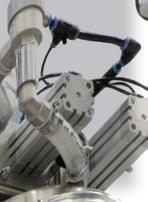
Rotzinger Group | rotzingergroup.com




A lot of our customers can’t talk about their secret to safe, smooth, gentle conveying but everyone knows the secret is Volkmann. Our patented pneumatic vacuum conveyors automatically transfer powders and other bulk materials from one point to another in fully enclosed, dust-tight, explosionproof systems.


Automated, hygienic and quiet
Easy to use, easy to clean
No tools disassembly
Stainless steel as standard
Fast lead times, easy to install
See action videos, get free test at Volkmannusa.com







Built for high-speed weighing applications, the Ishida multihead weigher achieves an internal calculation of 0.01 g weighing accuracy. The Ishida CCW-AS weigher has a tablet touchscreen with intuitive operation and visual capabilities that assist with IoT connectivity and data handling capacity. Featuring a hygienic design, it can be used with snack foods; fresh produce and salads; meat, poultry, and seafood; prepared foods; meat alternative products; frozen vegetables; candy and confectionery; baked snacks; cheese; french fries; fruit; and petfood.

Heat and Control | heatandcontrol.com


Mettler Toledo inspection device management software is compatible with virtually all Mettler Toledo metal detectors, checkweighers, X-ray systems, and vision inspection systems. The ProdX software Version 2.6 intuitive user interface allows users to monitor data, review contamination events, and run reports from a web client on any in-network PC. It enables the automated generation of final evaluations and summary reports at the end of every product run, shift, or day. The product validation capability prevents product settings from being changed and displays a visual indicator to confirm the system is running an established, validated recipe.
Mettler
Toledo Product Inspection Group mt.com/piBuilt for the processing of medium- to high-viscosity products, the Ross multishaft mixer features a twowing center-mounted agitator with a contoured bottom and Teflon scrapers that motivate viscous product throughout the mixing zone; a long helical flight agitator for top-to-bottom mixing; and a dual propeller agitator for low-shear, high-flow mixing. Designed for internal pressures up to 50 psi, the tank of the VM-450-gal VersaMix mixer is fabricated from 304 stainless steel. The mixer has an integrated two-way flush tank ball valve, 14-in. manway for ingredient additions and cleaning operations, and 7-in. color touchscreen interface.

 Charles Ross & Son | mixers.com
Charles Ross & Son | mixers.com
Designed for clean-in-place (CIP) processes, the 4T2 Sensors impedance sensor generates an electrical fingerprint of the fluid in the pipe, allowing real-time, highresolution measurements. The CIPSense sensor detects concentrations, contamination, and mixtures of fluids. It seamlessly integrates with any SCADA system.
4T2 Sensors | 4t2sensors.com
IIoT ready, the Wago communication module controls power supplies and DC subsystems. With an intuitive web interface, the Wago Pro 2 EtherNet/IP with MQTT communication module commissions the power supply to help identify potential problems in real time with data, such as current and voltage, along with other warnings and alarms. The module can be used on newly designed or existing systems with upgrade capabilities that can be reconfigured on the fly.

Wago | wago.com
The Powder-Solutions self-cleaning magnet pneumatically retracts its magnet rods, rotates them, and wipes the magnetic materials to the end and into a collection chamber. Automatic cleaning can take place during, before, or after production runs. USDA Dairy accepted, the Mag-Ram magnet provides a 10,000+ gauss reading. Applications include the extraction of work-hardened stainless steel, wear iron, and tramp metal. Units can be sized to suit existing chutes and hoppers.


Powder-Solutions | powder-solutions.com

The Emerson data server makes intelligent field device information, such as configuration parameters, alerts, and calibration data, available in near real time, for use in applications and other software. The AMS device manager data server simplifies the importing of critical instrument and valve data into common dashboarding tools and applications, including Microsoft PowerBI; Emerson software tools, such as the Plantweb Optics platform; Plantweb Insight; Aspen MTell and AspenTech Inmation; and plant historians.

Emerson | emerson.com








The Volkmann feeder dosing system automatically weighs powders, pellets, flakes, and other bulk materials and doses them into hoppers, mixers, baggers, and vertical form/fill/ seal machines. The unit has a vibrator design that sets material in a uniform layer while advancing it toward discharge in a first-in, first-out process. It can be configured for loss-inweight feeding, gain-in-weight feeding, and continuous metering. ATEX certified as explosion-proof, the system has a stainless-steel construction in product contact areas.
Volkmann volkmannusa.com


Whether it’s groundbreaking end-of-line automation, flexible front-of-the-line processing equipment, innovative materials or sustainable supply chain solutions, you’ll encounter the latest advances in food packaging and processing up close at PACK EXPO Las Vegas. Get ideas from other industries and discover surprising solutions for your food products.
2,000 exhibitors 40+ vertical markets
free show floor sessions
Endless networking opportunities Featuring Newly Expanded
ProFood World® (ISSN 2476-06760, USPS 22310) is a registered trademark of PMMI, The Association for Packaging and Processing Technologies. ProFood World® is published 7x a year (February, April, June, August, September, October, December) by PMMI Media Group, 401 North Michigan Avenue Suite 1700, Chicago, IL 60611; 312.222.1010; Fax: 312.222.1310. Periodical postage paid at Chicago, IL, and additional mailing offices. Copyright 2023 by PMMI. All rights reserved. Materials in this publication must not be reproduced in any form without written permission of the publisher. Applications for a free subscription may be made online at www.profoodworld.com. Paid subscription rates per year are $55 in the U.S., $80 Canada and Mexico by surface mail; $130 Europe and South America. $200 in all other areas. To subscribe or manage your subscription to ProFood World, visit ProFoodWorld.com/subscribe. Free digital edition available to qualified individuals. POSTMASTER: Send address corrections to: ProFood World, 401 North Michigan Avenue, Suite 1700, Chicago, IL 60611. PRINTED IN USA by Quad Graphics. The opinions expressed in articles are those of the authors and not necessarily those of PMMI. Comments, questions and letters to the editor are welcome and can be sent to: ahand@pmmimediagroup.com. We make a portion of our mailing list available to reputable firms. If you would prefer that we don’t include your name, please write us at the Chicago, IL address. Volume 7, Number 4.
PMMI connects members to customers and provides the insights needed for customers and suppliers to solve problems together, for example:.

• PMMI’s ProSource is where customers go find solutions. Offered exclusively— and free—to PMMI members, ProSource is the premier online directory of technology suppliers. Learn more pmmi.org/prosource
• PMMI’s Custom Research gives members a competitive edge with personalized, proprietary insights that make clear what customers are looking for, and where you fit in the solution.
PMMI is your answer. Learn more pmmi.org/join

JOIN TODAY!
PMMI is your answer, connecting you to customers 365 days a year.
MICHAEL COSTA | SENIOR EDITOR
Apex Motion Control’s Baker-Bot does the heavy end-of-line lifting for Boichik Bagels, saving labor while increasing efficiency.
WHEN EMILY WINSTON’S favorite childhood bagel shop in New York City closed in 2012—the Upper West Side location of H&H Bagels—she was inspired to carry on their legacy of authentic New York-style bagels in her new home on the other side of the country in Berkeley, Calif.
“I grew up eating excellent bagels, and moved out here and the bagels were not as good,” says Winston. “I was so sad that I would never be able to eat my favorite bagel again. But I thought, maybe I could figure out how to make [that bagel] for myself. So, I started experimenting based on looking at recipes, and Googling how to make bagels with no professional baking experience or cooking background.”
Winston—a New Jersey native who has a background in mechanical engineering—kept trying to craft her perfect bagel at home, and after five years, “I had an awesome bagel and friends told me I should sell them,” she says. “So, I did a few pop-ups around town and they were a huge hit. After that, I did a lot of soul searching and put everything on the line to open a real bagel shop.”
Winston’s DIY bagel journey became Boichik Bagels, which opened a retail shop in Berkeley in 2019, and another location in Palo Alto, Calif., in 2022. Between those dates, the pandemic hit, which gave Winston an opportunity to explore wholesale and delivery opportunities with grocery stores and other offsite outlets, which proved very successful. This sparked an idea for a Boichikowned central production facility in Berkeley, where all dough for Boichik bagels would be produced in volume, then formed and proofed.
“Making the dough correctly is the trickiest part,” explains Winston, Boichik’s founder & CEO. “I really wanted to make the dough in one central location, and then send it out to our stores to have it baked fresh onsite.”
That 18,000-sq-ft plant opened in March this year and includes a retail shop with full view of Boichik’s production line through large windows for visiting customers and clients. One of the biggest visual attractions on that line is an Apex Motion Control Baker-Bot 10 collaborative robot (cobot), which pulls sheet pan-sized boards of
Boichik Bagels currently produces 8,000 bagels daily, while Founder & CEO Emily Winston says their goal is to produce 50,000 bagels each day as business continues to grow.


formed bagel dough off the end of the line and onto speed racks before being wheeled into a cooler to proof overnight.
“If we didn’t have the Baker-Bot, we would need one person doing that job, two if we’re running at full speed,” notes Winston. The line produces a sheet pan with 24 formed bagels every 7.5 seconds when it’s at full speed, “and that’s a really unpleasant job for someone to pick those up and put them in the rack. It doesn’t pay to give anyone repetitive stress injuries and it doesn’t make any financial sense to do that to your employees. I’m giving people better jobs and we actually have very low turnover for a food business. Part of it is because we invest in equipment that makes our jobs easier.”
Apex Motion Control developed custom end-ofarm tooling for Boichik for the Baker-Bot to pick up and slide the bagel boards into slots on speed racks. “It’s more fun to supervise a cobot than moving boards by hand all day,” Winston says. “Our employees can do something else instead. No one got fired because we bought this cobot. In fact, their jobs got better.”
Before Boichik opened their central production facility, the company was producing about 4,000 bagels a day at its two retail locations. Since the production line opened in March, Boichik is making about 8,000 bagels a day, although it can make 12,000 bagels in an hour if needed. Winston says as the business grows—which includes a direct-to-consumer web ordering option launching this month, plus a new retail store under construction in Santa Clara, Calif.—her goal is for Boichik to produce 50,000 bagels daily.
Boichik received a boost in publicity in 2021 when the New York Times profiled Winston and her company in a story, saying Boichik’s bagels were on par with the best bagels made in New York City. That confirmation of quality has brought a lot of attention and customer curiosity to Boichik, which is why Winston opted to build the food production equivalent of an open kitchen in a restaurant, where customers can watch the entire bagel-making process all the way down to the Baker-Bot at the end.
“Usually [companies] hide all their industrial equipment from the public, but people here love to see it, and I don’t think a Baker-Bot has really been on public display before,” Winston says. “We added the Baker-Bot into our line to make our production run more efficiently, but also because it looks cool. People come in here often to order a bagel and coffee and watch through the window as we make more bagels.”
Apex Motion Control www.apexmotion.com

















































































































Stainless steel servo motors from SEW-EURODRIVE keep things moving wherever machines and systems are subject to particularly intensive cleaning. With an IP69 protection rating, their hygienic properties, long operating life, and maintenance friendliness make them optimally suited in permanently wet environments like food and beverage and pharmaceutical industries.
